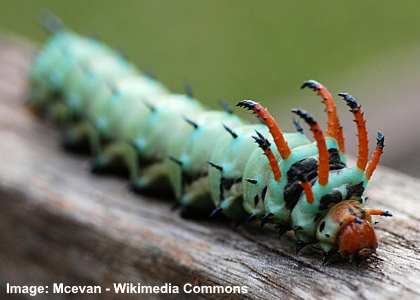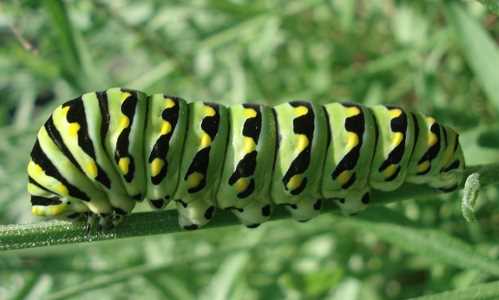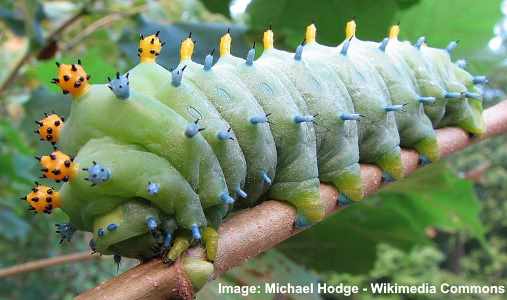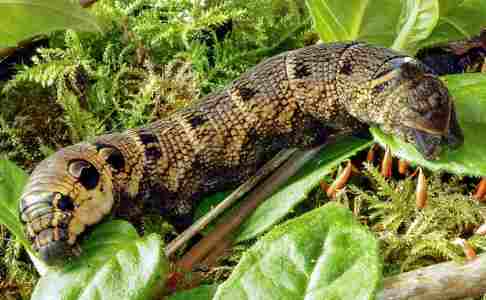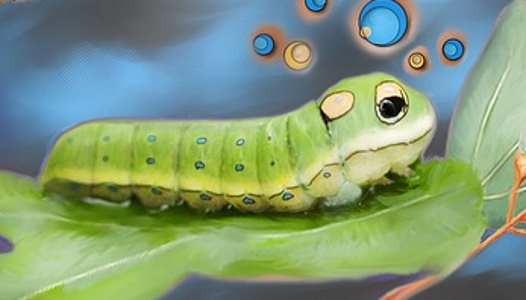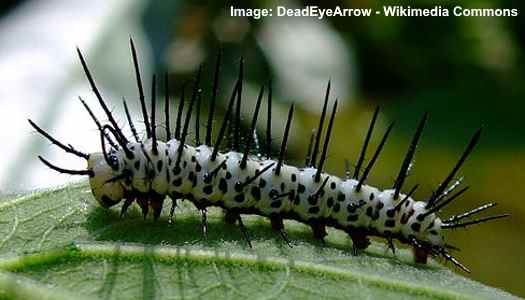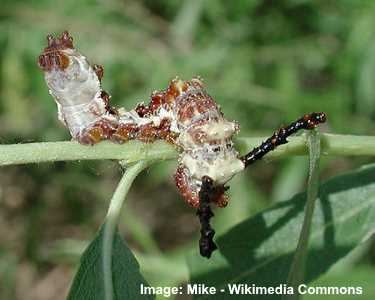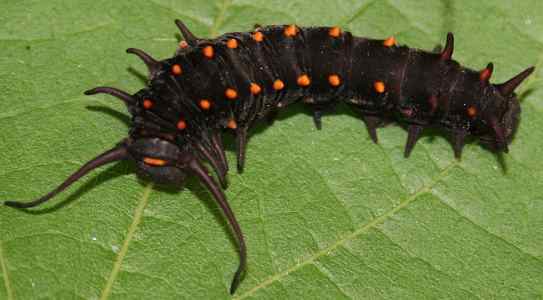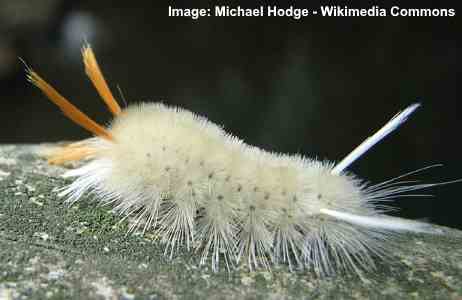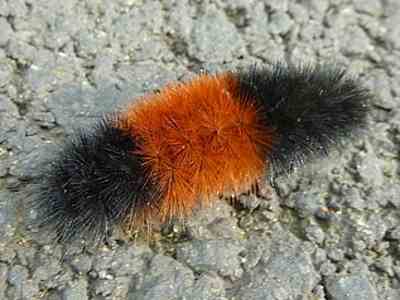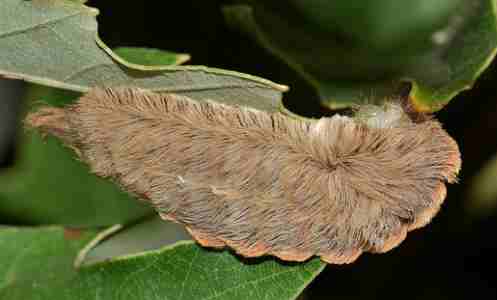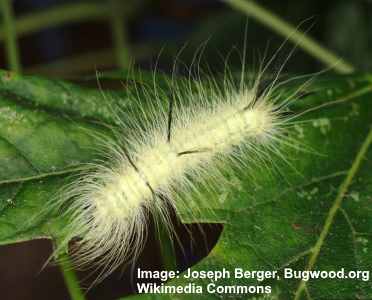67 Types of Caterpillars with Identification Chart & Pictures
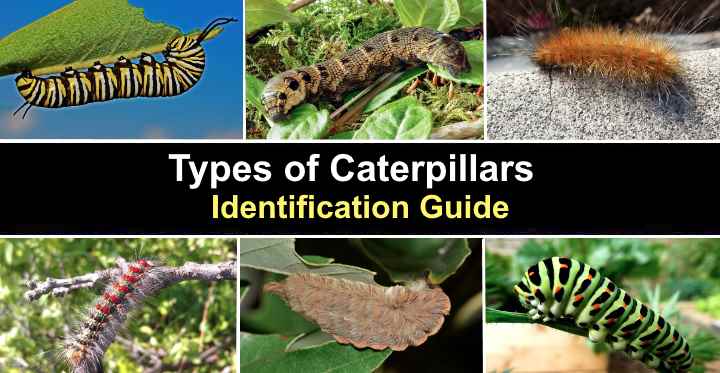
Caterpillars come in many shapes, sizes, colors, and types. Some types of caterpillars have soft smooth colorful bodies that can be green, black, orange, or white. Some of these caterpillars may have stripped bodies or have interesting camouflage markings. Other kinds of caterpillars have furry bodies, spiky bodies, or horns on their bodies or heads. A caterpillar identification chart can help you identify the different types of caterpillars.
A caterpillar is the larval stage of a moth or butterfly. It’s part of their four-stage life cycle: egg, larva, pupa, and adult. The caterpillar is the important second stage in this transformation process.
Understanding how to identify various types of caterpillars allows us to anticipate their transformations. For example, the distinctive black, yellow, and white-striped caterpillar transforms into the renowned monarch butterfly.
Another reason to be able to identify certain types of caterpillars is to recognize which ones are hazardous or venomous. For instance, the furry exterior of certain caterpillars can cause skin irritation upon contact.
Stinging caterpillars have hollow bristles containing toxic substances. Contact with these hazardous caterpillars can result in the release of venom, causing various reactions ranging from mild stinging and itching to intense pain. Certain spiky caterpillars, such as the giant silkworm moth caterpillar, are even known to be potentially lethal.
So you need to be careful when touching any fuzzy caterpillars even if they look harmless.
Caterpillar Identification
To identify caterpillars, it is important to take note of their size, color, type of hairy covering, and specific markings such as stripes, spots or ‘horns’. Most stinging caterpillars are identified by spine or fine hairs covering their body. Some types of furry caterpillars also look deceiving. For example, some woolly caterpillars look like soft fluffy worms. However, their bristles are a defense mechanism and it can be spiky and painful.
In this article, you will learn about many types of caterpillars and how to identify them properly. You will find out pictures of caterpillars and learn about their unique characteristics.
Types of Caterpillars (with Pictures and Names): An Identification Guide
Even though many types of caterpillars look different and have various characteristics, they all have one thing in common – they love to eat. For example, some types of caterpillars can increase their weight thousands of times in a few weeks.
Let’s look in more detail at these fascinating and interesting-looking worms.
Hickory Horned Devil (Regal Moth) Caterpillar (Citheronia regalis)
The hickory horned devil caterpillar (Citheronia regalis) has to top the list for the scariest-looking caterpillar. This green caterpillar has black-tipped orange prickly spikes at its head that look dangerous. However, despite its fierce horned appearance, this type of caterpillar is totally harmless.
Apart from being a scary caterpillar, the hickory horned devil is also one of the largest caterpillars in the world. Fully grown, this red and black horned caterpillar can grow up to 6” (15 cm). Its pale green plump segmented body has small black spines sticking out of it and black markings at its head section. This enormous caterpillar is also identified by a red patch at the end of its body.
As their name suggests, this big green fat caterpillar feeds on hickory leaves as well as cotton, hazel leaves, and ash tree leaves.
The hickory horned devil transforms into one of the biggest moths you can find.
- Adult Stage: Regal moth
- Host Plants: Primarily feeds on foliage of various trees such as hickory, walnut, sweetgum, and sumac
- Habitat and Distribution: Found in deciduous forests, gardens, and woodlands, primarily in North America, including the United States and parts of Canada
- Stinging: The hickory horned devil caterpillar does not possess stinging capabilities or cause skin irritation
Monarch Caterpillar (Danaus plexippus)
The monarch caterpillar (Danaus plexippus) is quite easy to identify with its black, white, and yellow stripes. Monarch caterpillars gorge on milkweed which makes them poisonous to other birds and insects.
Stripy monarch caterpillars grow to between 1” and 1.7” (2.5 – 4.5 cm) long. From its first stage, until is become a cocoon, this fascinating caterpillar will increase its weight by 2,000 times.
Apart from its soft stripped body, the monarch caterpillar has 2 pairs of tentacles. The monarch caterpillar turns into the famous monarch butterfly.
- Adult Stage: Monarch butterfly
- Host Plants: Mainly feeds on milkweed plants, including common milkweed, swamp milkweed, and others in the Asclepias genus
- Habitat and Distribution: Found in various habitats including fields, meadows, and gardens, primarily across North America, but also found in some parts of South America, Western Europe, and Australia
- Stinging: Monarch caterpillars do not sting or cause skin irritation
Black Swallowtail Caterpillar (Papilio polyxenes)
Identifying the black swallowtail caterpillar (Papilio polyxenes) is not difficult due to the black stripes and yellow dots on its plump lime-green body. Another characteristic of this green caterpillar is its forked tongue behind its head that sticks out when threatened.
Although this striped caterpillar looks similar to the monarch caterpillar, it doesn’t have tentacles at the head of its body. However, just like the monarch, the black swallowtail caterpillar also munches on milkweed which offers it protection from predators.
This is a type of caterpillar commonly found in North America. Other names for it include the ‘American Swallowtail’ and the ‘Parsnip Swallowtail.’ In its larvae stage, the black swallowtail also feeds on parsley, which is why it is also called the ‘parsley caterpillar.’
The smooth green body of this caterpillar from the Papilio genus doesn’t have any hairs or venomous spikes. So, you can safely handle this caterpillar if you want to keep it in captivity.
- Adult Stage: Black swallowtail butterfly
- Host Plants: Feeds on the leaves of various plants such as milkweed, including members of the carrot family (Apiaceae) such as parsley, dill, fennel, and Queen Anne’s lace
- Habitat and Distribution: Found in diverse habitats, including gardens, fields, meadows, and open areas, throughout North America
- Stinging: The black swallowtail caterpillar does not possess stinging capabilities or cause skin irritation
Cecropia Caterpillar
Another type of very large caterpillar is the Cecropia moth caterpillar with its fat green body and scary appearance.
You can identify the Cecropia caterpillar by its long length and orange, yellow, and blue nodules (tubercles). Although not as large as the horned devil, this giant caterpillar can grow up to between 4” and 4.5” (10 – 11 cm). Its frightening look is due to the differently-colored tubercles. Each of these protrusions has tiny black spikes.
Despite their freakish appearance, these enormous caterpillars are harmless. They don’t bite or sting and won’t cause any problems handling them. They get to their huge size by feeding on tree and shrub leaves.
As you would expect from such a large caterpillar, the Cecropia caterpillar metamorphoses into a large moth. In fact, the Cecropia moth is the largest moth native to North America.
- Adult Stage: Cecropia moth
- Host Plants: Feeds on the foliage of a variety of trees and shrubs, including maple, birch, cherry, apple, and other deciduous trees
- Habitat and Distribution: Found in diverse habitats such as forests, woodlands, and suburban areas, primarily across North America
- Stinging: The Cecropia caterpillar does not possess stinging capabilities or cause skin irritation
Elephant Hawk Moth (Deilephila elpenor)
Another unusual-looking caterpillar is the elephant hawk moth caterpillar (Deilephila elpenor). The name for this brown-colored caterpillar comes from its resemblance to an elephant’s trunk.
The moth larvae are identified by their gray-brown coloring and black spots along the side of its body. The brown caterpillar has an oval head with eye-spots on it. This gives the caterpillar a frightening look to predators who will tend to leave them alone. Another identifying feature of the elephant hawk caterpillar is the horn at the end of the body.
When fully grown, these caterpillars can measure up to 3” (7.5 cm).
- Adult Stage: Elephant hawk moth
- Host Plants: Feeds on various plants, including willowherb, bedstraw, and fuschia
- Habitat and Distribution: Found in various habitats such as gardens, meadows, and open areas, primarily across Europe, Asia, and parts of Africa
- Stinging: The elephant hawk moth caterpillar does not possess stinging capabilities or cause skin irritation
Spicebush Swallowtail Caterpillar (Papilio Troilus)
The spicebush swallowtail caterpillar (Papilio Troilus) is a type of caterpillar that looks like a tiny snake. It has a bright green body with small bluish rings around its segments, yellow color around its midsection and a thin line along the sides. One of the more unusual features of this caterpillar is its fake eyes on its head.
Some types of this caterpillar have a yellow-green color rather than pale green. However, the distinctive markings that offer protection from predators are a common identifying feature of this caterpillar. If the caterpillar feels threatened, it will rear up and emit a foul-smelling odor to ward off birds and other insects.
It may be difficult to spot this caterpillar as it is usually feeds at night and hides during the day.
When the larvae emerge from their pupae, they are a stunning example of black-colored butterflies.
- Adult Stage: Spicebush swallowtail butterfly
- Host Plants: Feeds primarily on the foliage of spicebush (Lindera benzoin) and sassafras (Sassafras albidum) plants
- Habitat and Distribution: Found in various habitats such as forests, woodlands, and gardens, primarily in eastern North America
- Stinging: The spicebush swallowtail caterpillar does not possess stinging capabilities or cause skin irritation
Zebra Longwing Butterfly Caterpillar (Heliconius charithonia)
The zebra longwing caterpillar (Heliconius charithonia) is identified by its long black spikes protruding from its grayish-green or whitish-gray body. As well as these long spikes, black dots along its body adds to its scary look.
This spiky caterpillar gorges on varieties of passionflower. Compounds in the passionflower plant turn into toxic compounds in the zebra longwing caterpillars. This makes them foul-tasting to any potential predators.
The name for these caterpillars comes from the beautiful butterflies that emerge from the pupae. The long jaggy-looking caterpillars transform into butterflies with black and white striped wings.
- Adult Stage: Zebra longwing butterfly
- Host Plants: Feeds on various passionflower vine species, including Passiflora suberosa and Passiflora incarnata
- Habitat and Distribution: Found in a variety of habitats such as tropical forests, gardens, and coastal areas, primarily in the southern United States, Mexico, Central America, and South America
- Stinging: The zebra longwing butterfly caterpillar does not possess stinging capabilities or cause skin irritation
Tobacco Hornworm Caterpillar (Manduca sexta)
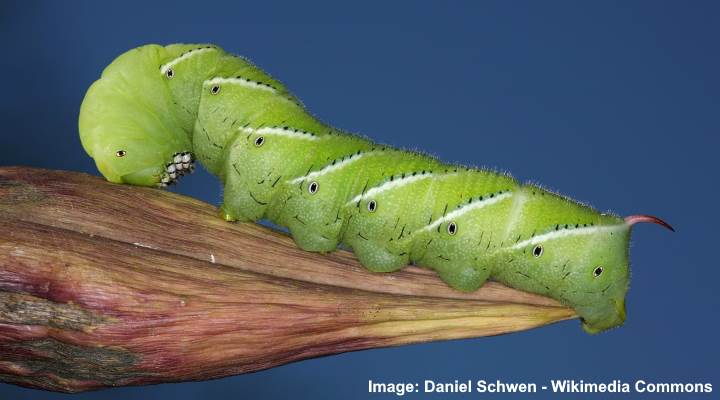
The Tobacco Hornworm caterpillar is a type of large green caterpillar
The large green tobacco hornworm caterpillar (Manduca sexta) is harmless to humans but can eat their way through your tomato plants. Compared to some other types of caterpillars, this common caterpillar species can be a serious pest in your garden.
Although not as huge as the hickory horned devil caterpillar, the tobacco hornworm is identified among the large types of caterpillars. Fully grown, the caterpillar can reach up to 4” (10 cm) in length. Its lime-green body has 7 faint white diagonal stripes on each side of its body.
This caterpillar specimen looks quite harmless apart from its orange or reddish-pink hook at its tail end. However, even this horned end won’t do any harm if you touch it.
The tobacco hornworm caterpillar transforms into a ginormous moth called the ‘Tobacco Hawk moth.’
- Adult Stage: Tobacco hawk moth
- Host Plants: Feeds primarily on the leaves of plants in the nightshade family, including tobacco plants, tomato plants, and other related species
- Habitat and Distribution: Found in various habitats such as gardens, agricultural fields, and open areas, primarily across North and South America
- Stinging: The Tobacco Hornworm Caterpillar does not possess stinging capabilities or cause skin irritation
Funerary Dagger Moth Caterpillar (Acronicta funeralis)
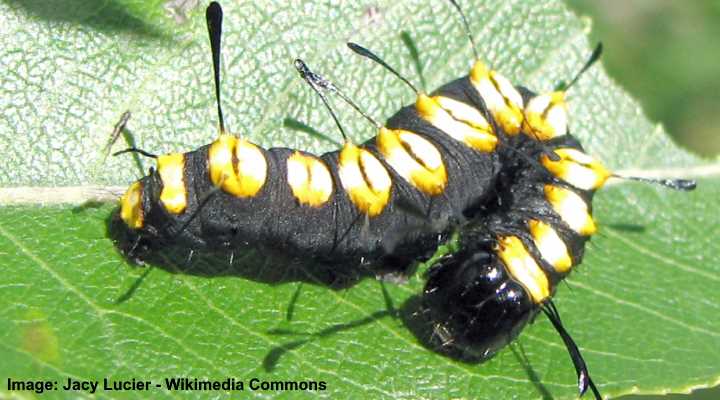
The Funerary Dagger caterpillar is also called the paddle caterpillar due to its paddle-like hairs
The funerary dagger caterpillar (Acronicta funeralis) is a striking example of a rare black-gray caterpillar species. Vivid yellow and white markings develop on the back of this soft caterpillar as it matures and make it easy to be identified.
One of the unusual features of this crawling larva bug is the strange paddle-like hairs that protrude from the sides of the caterpillar, giving it also the common name the ‘paddle caterpillar’.
Funerary dagger moths feed on, among others, the leaves of birch, cottonwood, apple, oak, and hickory trees.
- Adult Stage: Funerary dagger moth
- Host Plants: Feeds on a variety of deciduous trees and shrubs, including oak, hickory, maple, and walnut
- Habitat and Distribution: Found in various habitats such as forests, woodlands, and suburban areas, primarily in North America
- Stinging: The funerary dagger moth caterpillar does not possess stinging capabilities or cause skin irritation
White Admiral Caterpillar (Limenitis arthemis)
One way to identify the white admiral caterpillar (Limenitis arthemis) is by its two black horns protruding from its head. This is a type of caterpillar that camouflages itself by resembling birds’ droppings.
The jaggy-looking caterpillar has an olive-green and brown body with discolored white blotches. The brown look of these crawling larvae also acts as good camouflage on wood and trees.
You can usually find white admiral caterpillars on aspen, birch, willow, and cherry trees.
Butterflies that emerge from the Limenitis arthemis species can be black and white, dark red, purple, or shades of blue. This type of butterfly is also known as the red-spotted purple butterfly.
- Adult Stage: White admiral butterfly
- Host Plants: Feeds on various species of plants, including birch, cherry, poplar, and willow
- Habitat and Distribution: Found in diverse habitats such as forests, woodlands, and along streams, primarily across North America and some parts of Canada
- Stinging: The white admiral caterpillar does not possess stinging capabilities or cause skin irritation
Pipevine Swallowtail Caterpillar (Battus philenor)
There are a number of types of caterpillars in the swallowtail species, and the pipevine swallowtail (Battus philenor) is a glossy dark brown, almost black variety with fleshy spines and two lines of pointed bright orange bumps along its back.
This is definitely not a large variety of caterpillar. The fully-grown larvae only reach about 2” (5 cm) in length. As the larvae mature, they develop into a reddish type of caterpillar covered in tiny fine hairs.
- Adult Stage: Pipevine swallowtail butterfly
- Host Plants: Feeds on various species of pipevine plants, including the Dutchman’s pipe (Aristolochia species)
- Habitat and Distribution: Found in a variety of habitats such as forests, woodlands, and gardens, primarily in the southern and eastern regions of North America
- Stinging: The pipevine swallowtail caterpillar does not possess stinging capabilities or cause skin irritation
Other interesting types of swallowtail caterpillars include some of the following:
- Spicebush Swallowtail caterpillar that has a pale orange or light brown body with rows of blue dots. As with some other types of Swallowtails, this has fake eyes on its head.
- Common Mormon caterpillar is a green caterpillar with a few brown or black-colored stripes across its back.
- Citrus Swallowtail caterpillar is a large fat lime-green caterpillar that loves to feed on the leaves of citrus trees. This type of caterpillar is slightly hairy in its immature stage and gradually develops a smooth body as it matures.
Type of Furry or Fuzzy Caterpillars with Pictures – Caterpillar Identification
Hairy types of caterpillars can be some of the most fascinating larvae around. Here are some of the interesting types of furry caterpillars.
The Sycamore Tussock Caterpillars (Halysidota harrisii)
The sycamore tussock caterpillar (Halysidota harrisii) is a light yellow or whitish furry caterpillar common to the Eastern United States and Mexico.
The whole body of this fuzzy caterpillar is covered in long fine yellow-white hairs. Its striking fuzzy appearance is enhanced by two tufts of long fuzzy spines at its head and tail ends—two are orange near the head, and two are white.
Although the fine hairs are not poisonous, repeated handling of them can cause skin irritation and hives.
As their name suggests, these sycamore tussock caterpillars feed on the leaves of sycamore trees. A large number of these hairy caterpillars can also damage the health of a sycamore tree.
- Adult Stage: Sycamore tussock moth
- Host Plants: Feeds on a variety of deciduous trees and shrubs, including sycamore, maple, oak, and elm
- Habitat and Distribution: Found in various habitats such as forests, woodlands, and urban areas, primarily in North America
- Stinging: The sycamore tussock caterpillar does not possess stinging capabilities or cause skin irritation
The Woollybear Caterpillar (Pyrrharcita isabella)
One of the identifying features of the woollybear caterpillar (Pyrrharcita isabella) is its furry black fuzzy body with a orange band around its middle. This hairy caterpillar species is also called the Isabella tiger moth or banded woolly bear.
This hairy-looking caterpillar may resemble a small bottle cleaner due to is short bristles. This black and orange fuzzy caterpillar grows to about 2” (5 cm) in length and is common in North America and Europe. This fuzzy caterpillar also survives well in cold climates.
In fact, one of the unique features of this woolly worm is its ability to survive the cold. Usually, during winter months caterpillars have to pupate to get through the winter. However, woollybears develop a chemical that acts as antifreeze in their bodies.
This caterpillar species rarely becomes a garden pest. Although they eat garden plants, they don’t consume so much as to cause damage.
Even though this caterpillar is called ‘woolly,’ it doesn’t have a soft touch to it. Its bristles have a spiky feel and may cause some skin irritation if handled too much.
Not all woollybear caterpillars have a black-orange color. There is also the yellow woollybear (Spilosoma virginica) which has a pale-yellow color. This transforms into the Virginia tiger moth after metamorphosis.
- Adult Stage: Isabella tiger moth
- Host Plants: Feeds on a variety of plants, including clover, dandelion, sunflowers, and other herbaceous plants
- Habitat and Distribution: Found in diverse habitats such as meadows, fields, and gardens, primarily across North America
- Stinging: The Woollybear Caterpillar does not possess stinging capabilities but may cause some skin irritation
Puss (Southern Flannel Moth) Caterpillar (Megalopyge opercularis)
The southern flannel (Megalopyge opercularis) is also called the puss caterpillar and is a small type of fluffy hairy caterpillar.
One of the identifying features of this venomous caterpillar is its long hairy beige-orange tail. Also, some types of this woolly caterpillar have orange line running down each side.
Even though this looks like a soft fluffy caterpillar, it is not one you want to handle. Soft-looking pale orange hairs cover rows of venomous spines that can give you a nasty sting. In some cases, an allergic reaction to the sting of this caterpillar could have serious consequences.
Some people say that the puss caterpillar resembles a disheveled orange toupee.
- Adult Stage: Southern flannel moth
- Host Plants: Feeds on various trees and shrubs, including oak, elm, and sycamore
- Habitat and Distribution: Found in diverse habitats such as forests, gardens, and urban areas, primarily in the southern United States, Mexico, and parts of Central America.
- Stinging: The puss caterpillar possesses venomous spines that can cause severe pain and skin irritation if touched
American Dagger (Acronicta americana)
The long thin spines on the American dagger species of caterpillar (Acronicta americana) give it a distinct fuzzy look. The black markings on this white caterpillar also add to its striking fuzzy appearance. You will also notice long black pencil hairs poking up from its back.
Some types of these caterpillars also have a yellowish color. Due to the shaggy nature of the hairs, it can be difficult to see the black head underneath its yellow “mane.” You have to handle this hairy caterpillar with care as the short yellow hairs are mildly toxic.
Fluffy American dagger caterpillars love to gorge on oak, elm, willow, hickory, and birch leaves.
- Adult Stage: American dagger moth
- Host Plants: Feeds on a variety of deciduous trees and shrubs, including birch, elm, oak, and maple
- Habitat and Distribution: Found in various habitats such as forests, woodlands, and urban areas, primarily in North America
- Stinging: The American dagger caterpillar does not possess stinging capabilities but may cause skin irritation
European Gypsy Caterpillar (Lymantria dispar dispar)
The European gypsy caterpillar (Lymantria dispar dispar) is native to Europe, Asia, and most of the States in the US including California. The fully-grown hairy caterpillar can grow up to 2” (5 cm) in length, thus making it a smaller type of caterpillar than some of the huge varieties.
This long thin fuzzy caterpillar has a whitish appearance with what looks like red and blue LED lamps on its back. These spots are what help identify this caterpillar from other species. Long thin white hairs protrude from its sides, head, and tail end. There are also clumps of shorter black hairs running down its back.
Because of the incredible damage that these furry bugs can do, the European gypsy caterpillar is considered a pest. You should also avoid handling the spiky creature as the fuzzy hairs can cause skin irritation.
- Adult Stage: European gypsy moth
- Host Plants: Feeds on a wide variety of trees and shrubs, including oak, birch, willow, and many other deciduous tree species
- Habitat and Distribution: Found in various habitats such as forests, woodlands, and urban areas, primarily in Europe and some parts of North America where it has been introduced
- Stinging: The European gypsy caterpillar does not possess stinging capabilities but can cause skin irritation
Silver-Spotted Tiger Caterpillar (Lophocampa argentata)
One black and orange fuzzy type of caterpillar is the silver-spotted tiger species (Lophocampa argentata). This mildly-toxic variety of caterpillar has a hairy appearance resembling the stripes of a tiger.
Usually, this type of caterpillar is found on fir trees on the West coast of North America including California, Nevada, Colorado, and Arizona.
- Adult Stage: Silver-spotted tiger moth
- Host Plants: Feeds on a variety of plants including oak, willow, maple, and other deciduous trees
- Habitat and Distribution: Found in various habitats such as forests, woodlands, and gardens, primarily in North America
- Stinging: The silver-spotted tiger caterpillar does not possess stinging capabilities but may cause skin irritation
Emperor Moth Caterpillar (Saturnia pavonia)
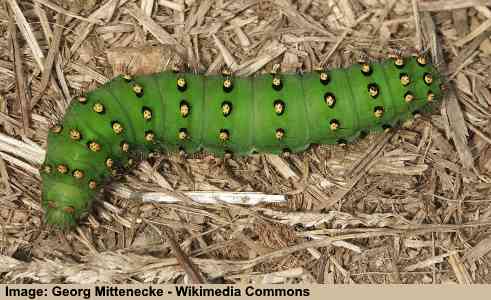
The Emperor caterpillar has yellow and black dots on its large green body
The emperor moth caterpillar is a large green crawling insect with small yellowish spiky growths (tubercles) around its segments. Close-up pictures of this caterpillar show tufts of fine white hairs emerging from the emperor moth caterpillar’s yellowish and black bumps. The dark green caterpillars grow up to 2.4” (6 cm) long.
Emperor moth larvae can be hard to recognize during their growth stages (instars). The crawling “grubs” emerge black and gradually turn green as they fatten up. However, some species of emperor moth caterpillars stay dark, almost black with yellow dots on the bodies.
- Adult Stage: Emperor moth
- Host Plants: Feeds on various plants including heather, bramble, and hawthorn
- Habitat and Distribution: Found in a variety of habitats such as grasslands, heathlands, and open woodlands, primarily in Europe and parts of Asia
- Stinging: The Emperor moth caterpillar does not possess stinging capabilities or cause skin irritation
Tiger Swallowtail caterpillar (Papilio glaucus)

The green tiger swallowtail caterpillar has eye-like markings on its head
The tiger swallowtail caterpillar is an unusual dark green caterpillar due to its eye-like spots on its head. Some characteristics of the swallowtail caterpillar are a yellow band behind its head, fake eyes, a smooth green body, and four pairs of stumpy prolegs. The caterpillar grows up to 2.2” (5.5 cm) long.
A defensive feature of the tiger swallowtail is that it releases a putrid odor when threatened. Like some other species of green caterpillar, it may display a forked spike like a snake’s tongue from behind its head.
- Adult Stage: Tiger swallowtail butterfly
- Host Plants: Feeds on various plants including wild cherry, tulip tree, and ash
- Habitat and Distribution: Found in a variety of habitats such as woodlands, parks, and gardens, primarily in North America
- Stinging: The tiger swallowtail caterpillar does not possess stinging capabilities or cause skin irritation
Luna moth caterpillar (Actias luna)
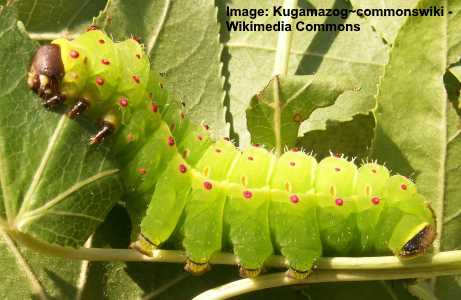
The large Luna caterpillar has green ridged body with red dots
The luna moth caterpillar is a sizeable bright green larva with an almost translucent body with rows of red spiny bumps. Some recognizable features of the luna moth caterpillar are its oval brown head, three pair of front legs, spiny red dots along its back and sides, and four pairs of large prolegs.
When it reaches maturity, the luna moth caterpillar grows to around 3.5” (9 cm) long. You can spot this large caterpillar feeding on birch, hickory, walnut, and alder tree leaves.
- Adult Stage: Luna moth
- Host Plants: Feeds on the foliage of various trees, including birch, sweetgum, hickory, walnut, and sumac
- Habitat and Distribution: Found in diverse habitats such as woodlands, forests, and gardens, primarily across North America
- Stinging: The luna moth caterpillar does not possess stinging capabilities or cause skin irritation
Garden Tiger caterpillar (Arctia caja)
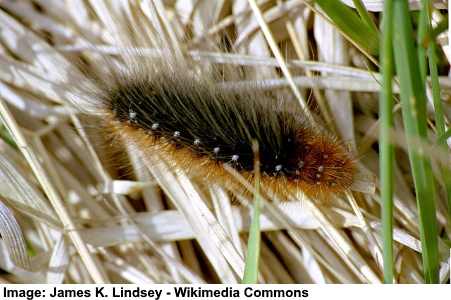
The fuzzy garden tiger moth caterpillar has black, orange and gray hair-like spines
The garden tiger caterpillar is a furry black and orange caterpillar with long feathery spines that make the caterpillar look like a porcupine. The garden tiger has a black body, and its fuzzy spines are a grayish-white, black, or orange color. Also, the “woolly” caterpillar has an orange head and light copper-colored band along its sides.
The garden tiger caterpillar is a type of woolly bear caterpillar. The furry caterpillar grows up to 2.4” (6 cm) long. Its long whitish spines and fuzzy body help protect the larva against predators.
- Adult Stage: Garden tiger moth
- Host Plants: Feeds on various plants including nettle, hound’s-tongue, and comfrey
- Habitat and Distribution: Found in a variety of habitats such as meadows, grasslands, and gardens, primarily in Europe and parts of Asia
- Stinging: The garden tiger caterpillar does not possess stinging capabilities or cause skin irritation
Cabbage White Butterfly Caterpillar (Pieris rapae)
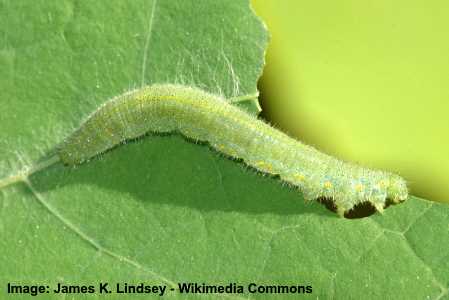
The green Cabbage White Butterfly Caterpillar is commonly found on cruciferous vegetables
The long, thin, green cabbage white caterpillar has an identifiable yellowish-green body and a slightly fuzzy appearance. As its name suggests, this caterpillar species gorges on cabbage leaves as it grows to maturity. Due to its voracious appetite, the green caterpillar is a significant garden pest.
The white cabbage caterpillar grows up to 1.4” (3.5 cm) long. Unlike many other types of green caterpillar, this green larval insect has a slender body without noticeable segments.
- Adult Stage: Cabbage white butterfly
- Host Plants: Feeds on various plants from the Brassicaceae family, including cabbage, broccoli, and mustard greens
- Habitat and Distribution: Found in diverse habitats such as gardens, agricultural areas, and open spaces, primarily across Europe, Asia, and North America
- Stinging: The cabbage white butterfly caterpillar does not possess stinging capabilities or cause skin irritation
Scarce Dagger Caterpillar (Acronicta auricoma)

The Scarce Dagger caterpillar has pale dots on the back of its black body with orange/yellow spikes
The scarce dagger caterpillar is a furry black caterpillar with recognizable tufts of orange hairs. Looking closely at this caterpillar, you’ll notice that each segment has bands of orangey bumps with hairs (setae) growing from them. The scarce dagger caterpillar measures 1.4” (3.5 cm) long when mature.
Depending on the instar, the scarce dagger caterpillar looks like a fuzzy orange or a black caterpillar with orange hairs and bright white or yellow dots.
- Adult Stage: Scarce dagger moth
- Host Plants: Feeds on various deciduous trees and shrubs, including birch, willow, and oak
- Habitat and Distribution: Found in various habitats such as forests, woodlands, and suburban areas, primarily in Europe and parts of Asia
- Stinging: The scarce dagger caterpillar does not possess stinging capabilities or cause skin irritation
Mourning Cloak Caterpillar (Nymphalis antiopa)
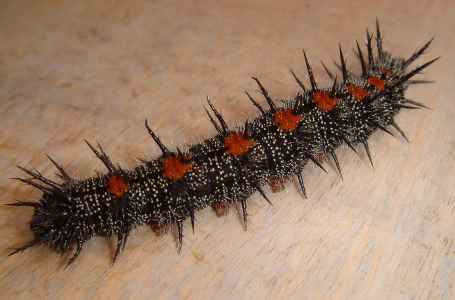
The spiky black mourning cloak caterpillar has orange-red markings and tiny white dots on its body
Also called the spiny elm caterpillar, the mourning cloak larvae is a black spiky caterpillar with eight orange tufts of short hairs along its back, tiny white dots, and menacing-looking fleshy black spines. Although the black caterpillar looks like it stings, it is entirely harmless. Mourning cloak caterpillars grow up to 2” (5 cm) long.
To spot mourning cloak caterpillars, look for the spiny black larvae feeding on cottonwood, aspen, hackberry, and birch trees. As the common name suggests, Nymphalis antiopa is often found eating its way through elm tree leaves.
- Adult Stage: Mourning cloak butterfly
- Host Plants: Feeds on a variety of trees including willow, elm, poplar, and hackberry
- Habitat and Distribution: Found in diverse habitats such as woodlands, parks, and gardens, primarily across North America, Europe, and Asia
- Stinging: The mourning cloak caterpillar does not possess stinging capabilities or cause skin irritation
Azalea Caterpillar (Datana major)
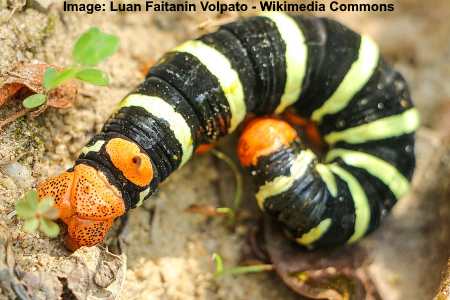
The Azalea Caterpillar has a stripy green and black body with orange head and tail
The azalea caterpillar is a black and yellow or green striped caterpillar with a large, rounded orange or rusty brown head. The several yellowish-green stripes on the caterpillar run longitudinally. As the long stripy worm-like insect grows, long white spines and orangey-red feet develop as it matures.
Mature azalea caterpillars mature to 2” (5 cm). The hungry caterpillars can quickly skeletonize leaves, and you can see them feeding on azaleas, rhododendrons, and blueberries.
- Adult Stage: Azalea sphinx moth
- Host Plants: Feeds primarily on the foliage of azalea, and occasionally on other plants such as blueberries and Andromeda
- Habitat and Distribution: Found in gardens, forests, and shrublands, primarily in North America
- Stinging: The azalea caterpillar does not possess stinging capabilities or cause skin irritation
Yellow Spotted Tussock Moth Caterpillar (Lophocampa maculata)
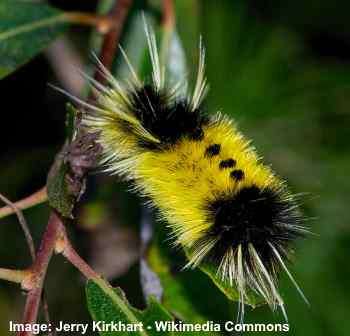
The yellow-spotted tussock caterpillar has a distinctive look with its yellow and black hairs
The yellow-spotted tussock caterpillar is a fuzzy yellow and black caterpillar covered in spines, making it look like a bottle brush. The characteristics of this small caterpillar are a furry black tail and head, long pencil-thin white spiky hairs, a yellow central band, and four black dots on its back. You can spot this yellow tussock caterpillar feeding on oak, willow, maple, and poplar tree leaves.
Yellow-spotted tussock caterpillars grow up to 1” (2.5 cm) long.
- Adult Stage: Yellow spotted tussock moth
- Host Plants: Feeds on a variety of plants, including oak, willow, maple, and various other deciduous trees and shrubs
- Habitat and Distribution: Found in diverse habitats such as forests, woodlands, and urban areas, primarily in North America
- Stinging: The yellow spotted tussock moth caterpillar can cause skin irritation upon direct contact due to the presence of irritating hairs.
Black and Yellow Zebra Caterpillar (Melanchra picta)
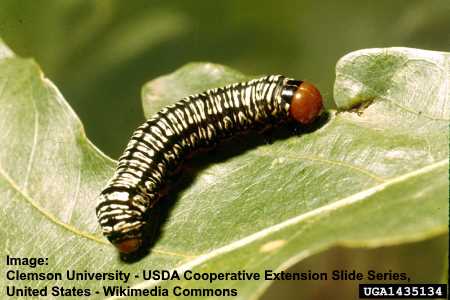
The black and yellow striped zebra caterpillar can be identified by its reddish-brown head
The stunning zebra caterpillar has a black body with zebra-like yellow patterns running lengthwise in four stripes. The hungry caterpillars have a rounded orange-bronze head and tail end. Immature larvae are primarily white with black heads. By the last stage, the caterpillars turn into colorful insects with interesting striped patterns.
Zebra caterpillars grow up to 1.6” (4 cm) long. Before turning into the American noctuid moth, the caterpillar can be found gorging on cabbages, beet, and other root vegetable leaves.
- Adult Stage: Black and yellow zebra moth
- Host Plants: Feeds on a variety of plants, including alder, birch, oak, and other deciduous trees and shrubs
- Habitat and Distribution: Found in diverse habitats such as forests, woodlands, and urban areas, primarily in Europe and parts of Asia
- Stinging: The black and yellow zebra caterpillar does not possess stinging capabilities or cause skin irritation
Mullein Moth Caterpillar (Cucullia verbasci)
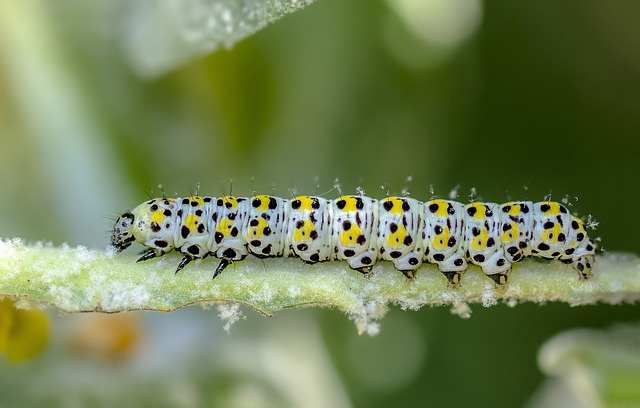
The beautiful mullein moth caterpillar is identified by its white or pale green body with black and yellow spots
The mullein moth caterpillar is a striking whitish-gray caterpillar with black-spotted yellow patches and black dots in random patterns. Pictures of this black and yellow caterpillar show three pairs of pointed feet at the head and four pairs of black and white prolegs. Also, look for small tufts of white or black short spines covering its back. Mullein moth caterpillars grow to 2” (5 cm) long.
Due to its bright coloring, it’s easy to identify the mullein moth caterpillar as it munches on buddleia plant leaves. The hungry crawling insects can quickly defoliate shrubs as they feed during July and August.
- Adult Stage: Mullein moth
- Host Plants: Feeds primarily on mullein plants (Verbascum species) and occasionally on figwort and other related plants
- Habitat and Distribution: Found in various habitats such as gardens, meadows, and grasslands, primarily in Europe, Asia, and parts of North America
- Stinging: The mullein moth caterpillar does not possess stinging capabilities or cause skin irritation
Cinnabar Caterpillar (Tyria jacobaeae)
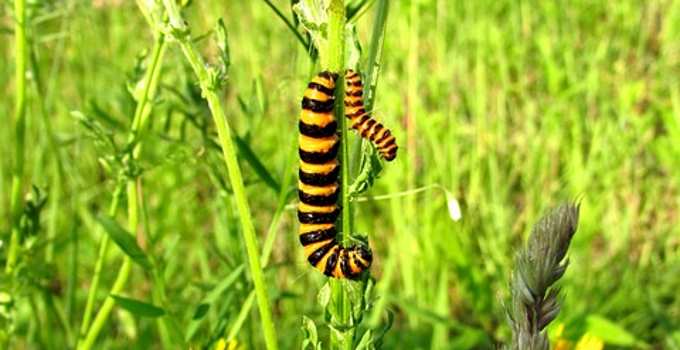
The cinnabar caterpillar has yellow and black stripes with fine hairs on its body
The cinnabar is a striped caterpillar with black and yellow stripes around its body. Characteristics of the cinnabar caterpillar include black and orange prolegs, black frontal legs, and feathery spines sticking out from its body. The black and orange striped caterpillar grows 1.2” (3 cm) long.
The cinnabar caterpillar is a type of poisonous caterpillar to predators. The stripy caterpillar gorges on ragwort which builds up toxins in the caterpillar.
The cinnabar caterpillars feed in groups, mainly in the daytime, from July to early September.
- Adult Stage: Cinnabar moth
- Host Plants: Feeds primarily on ragwort and groundsel, which are toxic to most animals but not to the cinnabar caterpillar
- Habitat and Distribution: Found in various habitats such as grasslands, meadows, and open areas, primarily in Europe, Asia, and some parts of North America
- Stinging: The cinnabar caterpillar does not possess stinging capabilities or cause skin irritation
Queen Butterfly Caterpillar (Danaus gilippus)

Queen Caterpillar has black and white stripes with yellow markings
One of the most striking colorful caterpillars you can see is the queen butterfly caterpillar. The traits of the queen caterpillar are long, fleshy, tentacle-like spines, a black and white striped body with yellow dots and black tentacles. In addition, the queen larvae mostly gorge on milkweed, making them distasteful to predators.
- Adult Stage: Queen butterfly
- Host Plants: Feeds on various species of milkweed, including Asclepias curassavica and other related plants
- Habitat and Distribution: Found in diverse habitats such as open areas, meadows, and gardens, primarily in North and South America
- Stinging: The queen butterfly caterpillar does not possess stinging capabilities or cause skin irritation
Oleander Caterpillar (Syntomeida epilais)
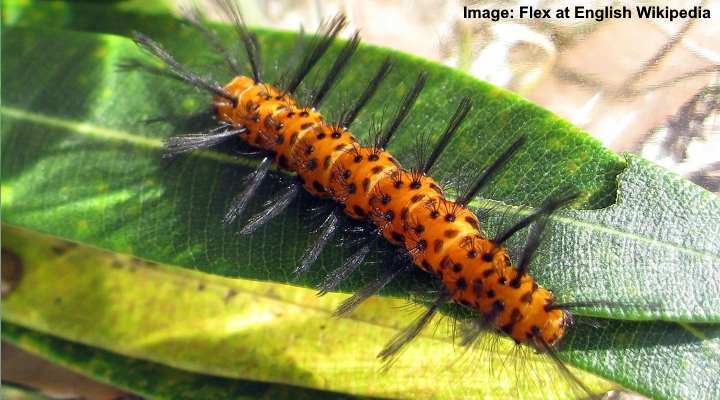
The oleander caterpillar has orange body with black bumps and tufts of hair
The oleander caterpillar is a brightly-colored orange caterpillar with long, straight pencil-thin black tufts of hairs emerging from black bumps along its sides. Other characteristics of the orange caterpillar’s appearance are black markings surrounding the body and tufts of short black, non-stinging spines on its back. Mature oleander caterpillars grow to around 1.5” (4 cm) long.
Oleander caterpillars are common in Florida, where they feed on oleander plants. Unfortunately, the caterpillars are a nuisance in Florida gardens, where they quickly defoliate shrubs when feeding on foliage.
- Adult Stage: Polka dot wasp moth
- Host Plants: Feeds primarily on oleander plants (Nerium oleander) and occasionally on other members of the Apocynaceae family
- Habitat and Distribution: Found in various habitats such as gardens, parks, and urban areas, primarily in the southern United States, Mexico, and parts of Central America
- Stinging: The oleander caterpillar can cause skin irritation upon direct contact due to the presence of irritating hairs
Stinging Rose caterpillar (Parasa indetermina)
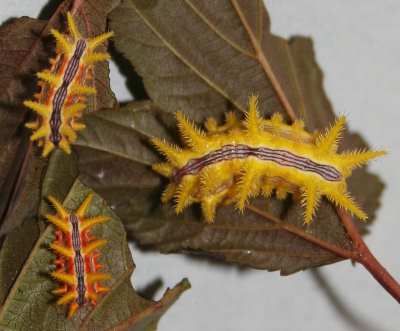
The Stinging Rose caterpillar has clusters of toxic spikes along its body
The stinging rose caterpillar is a flat-looking orange or yellow caterpillar with jagged spines that cause skin irritation when handled. The appearance of the stinging rose caterpillar has a band of purple and light blue stripes running down its back. There are also small tufts of stinging spines along the caterpillar’s sides.
Like the oleander caterpillar, stinging rose caterpillars are commonly found in Florida, South Georgia, Texas, and Oklahoma. You will spot the spiky orangey-yellow caterpillars on roses, where they cause severe damage to foliage.
- Adult Stage: Stinging rose caterpillar moth
- Host Plants: Feeds on a variety of plants including rose bushes, hibiscus, and other ornamental plants
- Habitat and Distribution: Found in gardens, parks, and forested areas, primarily in North America
- Stinging: The stinging rose caterpillar possesses spines that can cause skin irritation and mild stinging if touched
Saddleback caterpillar (Acharia stimulea)
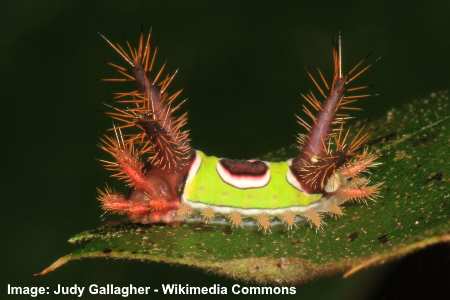
The Saddleback caterpillar has spiny venomous horns that cause painful sting
One of the most unusual caterpillars is the saddleback caterpillar. This stinging flat caterpillar has large protruding horns with jaggy spikes on them. The identifiable characteristic of the caterpillar is the saddle-like green marking on its back. This trait gives the saddleback caterpillar a look as if it has a green covering with a large brown patch in the middle.
As one of the scariest-looking caterpillars, the saddleback caterpillar has urticating orange bristles (stinging spines) on its body and long horns. The sting from a saddleback can cause pain, a skin rash, and possible nausea.
- Adult Stage: Saddleback moth
- Host Plants: Feeds on a variety of plants including elm, sycamore, and maple, as well as other deciduous trees and shrubs
- Habitat and Distribution: Found in various habitats such as gardens, forests, and urban areas, primarily in North America
- Stinging: The saddleback caterpillar possesses spines that can cause skin irritation and mild stinging if touched
Io Moth Caterpillar (Automeris io)
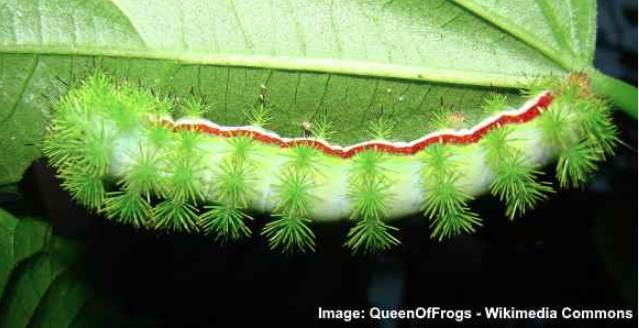
The Io moth caterpillar has green spikes that feel very unpleasant if their venom penetrates your skin
The Io moth larva is a striking caterpillar with vibrant green colors and clusters of urticating spines. It has a lime green body with two lateral stripes—one white and one red. Its most prominent feature is its rows of spiky, venomous-looking light green spines.
The Io moth caterpillar grows up to 2.7” (7 cm). During its several growth stages, the green caterpillar feeds on various host plants, including oak, maple, dogwood, and sycamore leaves. It is commonly found in open woodlands, gardens, and meadows throughout North America.
- Adult Stage: Io moth or peacock moth
- Host Plants: Mainly feeds on tree foliage like maple, oak, hazel, dogwood, and willow
- Habitat and Distribution: Found in deciduous forests, woodlands, and gardens in the eastern United States and parts of Canada
- Stinging: The Io caterpillar has venomous spines that cause a painful sting and skin irritation
White Flannel Moth Caterpillar (Norape ovina)
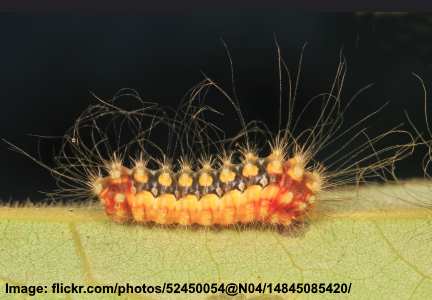
White Flannel Moth Caterpillar (Norape ovina)
The white flannel moth caterpillar is a venomous yellowish caterpillar covered in long, silky white hairs. Its identifying features are the black band on its orange-yellow body, tufts of stinging hairs, whitish spots on its body, with reddish brown-colored tips. Despite its soft, fluffy appearance, the colorful caterpillar can inflict nasty stings.
The white flannel moth caterpillar grows 1” to 1.25” (2.5 – 3.1 cm) long. You can find this stinging caterpillar gorging on foliage throughout the Eastern United States and west to Montana and Texas.
- Adult Stage: White flannel moth
- Host Plants: Mainly feeds on tree leaves from hackberry and redbud trees
- Habitat and Distribution: Found from Washington D.C. and south to Florida, then west as far as Texas
- Stinging: The white flannel moth caterpillar has venomous spines, resulting in a painful sting like a bee or wasp sting
White-Marked Tussock Caterpillar (Orgyia leucostigma)
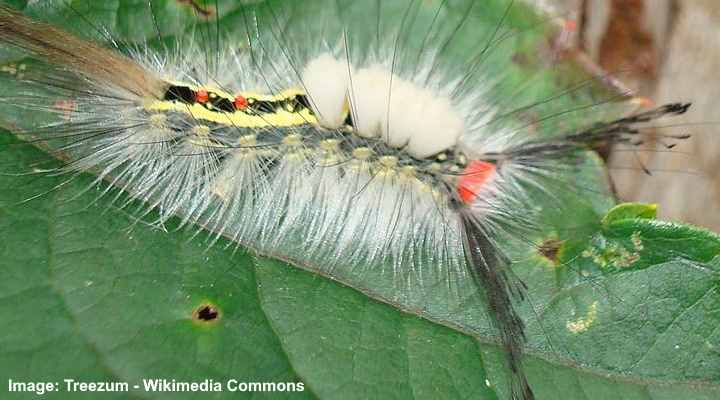
The hairy white-marked tussock caterpillar is easily identified by its unique look
The white-marked tussock caterpillar is a hairy caterpillar with distinctive tufts of white and black hairs. It has a red head, a black body with yellow stripes, and four distinctive creamy toothbrush-like white tufts on its back. The yellow and black caterpillar also has long black spines on its back and white tufts along its sides.
The white-marked tussock caterpillar grows up to 1.4” (3.5 cm) long. Although it looks furry, touching the fine hairs (setae) can cause an allergic skin reaction. The caterpillar spins a grayish cocoon before the adult moth emerges two weeks later.
- Adult Stage: White-marked tussock moth
- Host Plants: Feeds on the foliage of various deciduous trees, including oak, maple, apple, chestnut, hickory, hemlock, and birch
- Habitat and Distribution: Found in forests, woodlands, and gardens across North America
- Stinging: The white-marked tussock caterpillar has urticating hairs that can cause skin irritation and a rash if touched
Crowned Slug Caterpillar (Isa textula)
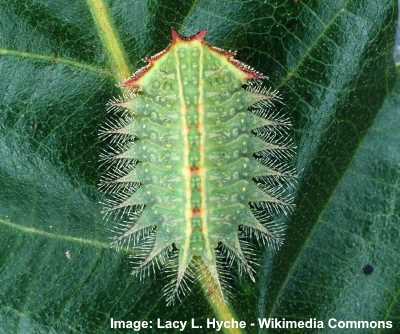
Crowned Slug Caterpillar (Isa textula)
The crowned slug caterpillar is one of the most stunning and unique caterpillars in North America. It has a flattened, crown-like, pale green body and rows of spiky, venomous-looking spines. The caterpillar has two distinctive yellow lines on its back, a pair of horns at the front, and tufts of stinging spines on its rear.
The crowned slug caterpillar grows around 0.6” (2.5 cm) long. Its flattened appearance, spiny projections, and ridged back make this green caterpillar easy to identify.
- Adult Stage: Crowned slug moth or skiff moth
- Host Plants: Feeds on the foliage of various trees, including oak, hickory, cherry, basswood, and elm
- Habitat and Distribution: Found in forests, woodlands, and gardens across Eastern North America and Southern Canada
- Stinging: The crowned slug caterpillar has venomous spines that can cause skin irritation and a painful sting if touched
Spiny Oak Slug Caterpillar (Euclea delphinii)
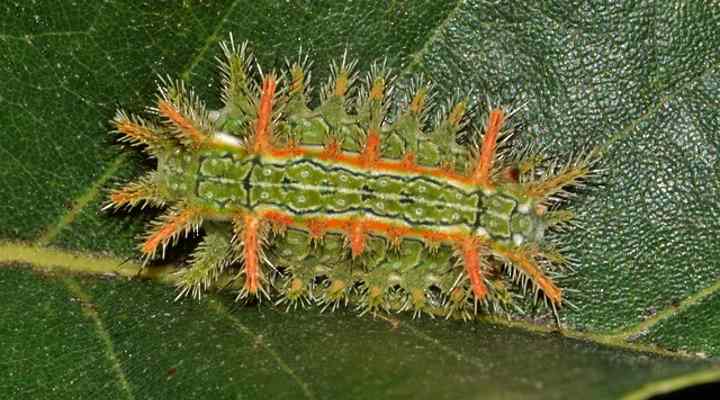
Spiny Oak Slug Caterpillar (Euclea delphinii)
The spiny oak slug caterpillar is easily identifiable by its bright green body with clusters of orange spine-like horns. Other features of this striking caterpillar are its two orange and white bands on its back, circular green patterns, and a flattened appearance. It also has venom-filled stinging tubercles.
The spiny oak slug caterpillar grows up to 0.8” (3 cm) long. Although its primary color is green, it can be mainly orange or dark green and yellow, depending on the caterpillar.
- Adult Stage: Spiny oak slug moth
- Host Plants: Feeds on the foliage of oak trees, as well as maple, cherry, and other deciduous trees
- Habitat and Distribution: Found on deciduous trees and shrubs across North America
- Stinging: The spiny oak slug caterpillar has stinging spines that can cause skin irritation, ranging from itching to burning.
Monkey Slug Caterpillar (Phobetron pithecium)
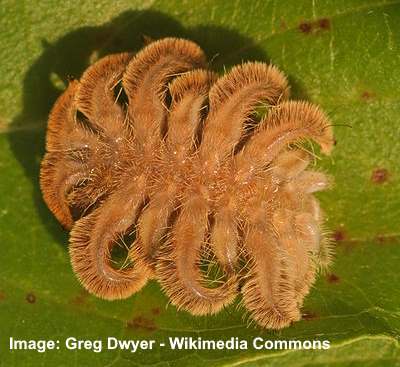
The hairs on the monkey slug caterpillar can cause skin irritation
The monkey slug caterpillar is one of the most unusual caterpillars due to its slug-like, brown, hairy appearance. The caterpillar has nine pairs of curled projections on a flattened body. Pictures of the distinctive caterpillar show it like a tangled mess of fur. Its stumpy legs underneath its body are suction cups.
The monkey slug caterpillar grows 0.6” to 1” (1.5 – 2.5 cm) long. The brown hairs are irritating and can cause skin irritation when handled. It tends to feed on foliage from deciduous trees.
- Adult Stage: Monkey slug moth or hag moth
- Host Plants: Feeds on the foliage of various trees, including oak, birch, hickory, maple, apple, oak, and elm
- Habitat and Distribution: Found in forests, woodlands, and gardens across North America
- Stinging: The monkey slug caterpillar has urticating setae that can cause skin irritation
Giant Leopard Moth Caterpillar (Hypercompe scribonia)
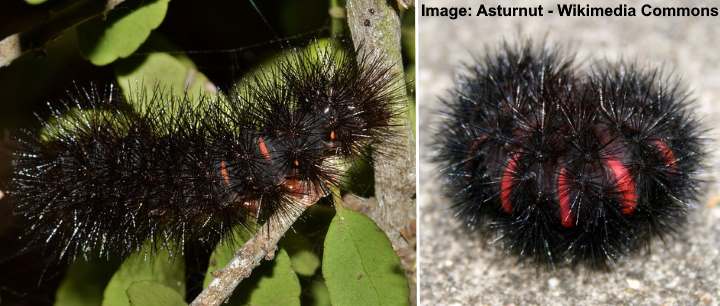
Giant Leopard Moth Caterpillar (Hypercompe scribonia)
The giant leopard moth caterpillar is a fuzzy black larva with red stripes. This “woolly bear” caterpillar is identified by its soft, fuzzy appearance and red stripes appearing when the caterpillar curls. Despite its soft appearance, its rows of black spines are sharp like needles.
The giant leopard moth caterpillar grows up to 2.5” (6.4 cm) long. Its contrasting black and red coloration makes it easily identifiable. Although it isn’t a stinging caterpillar, its sharp spines can puncture the skin.
- Adult Stage: Giant leopard moth
- Host Plants: Feeds on the foliage of various broadleaf plants
- Habitat and Distribution: Found in open areas, gardens, and meadows across North America
- Stinging: The giant leopard moth caterpillar doesn’t sting or cause irritation; however, its sharp needle-like can prick the skin
Variable Oak Leaf Caterpillar (Lochmaeus manteo)
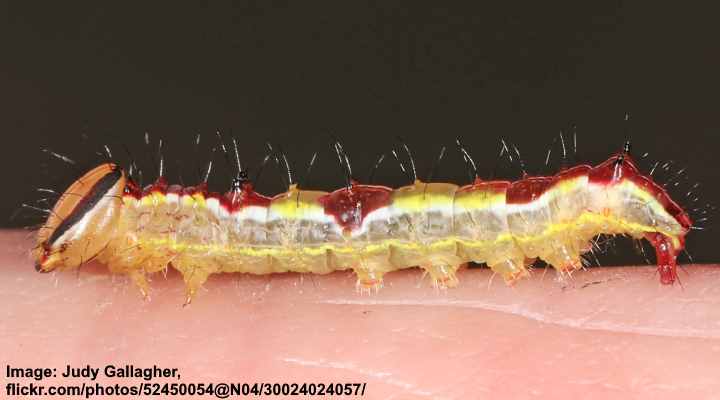
The variable oak leaf caterpillar can be dangerous as it spits out acid when under threat
The variable oak leaf caterpillar is a worm-like, cylindrical caterpillar with a striped body. This larva can range in color from yellow to green to reddish-brown. It’s identified by the series of black and yellow bands along its body. It also has thin and wispy setae along its sides and back.
The variable oak leaf caterpillar grows up to 1.5” (3.8 cm) long. A defensive feature of this slug-like larva is its ability to spray formic acid. This compound can cause severe skin irritation or blisters.
- Adult Stage: Variable oak leaf moth
- Host Plants: Feeds on the foliage of oak trees
- Habitat and Distribution: Found in oak forests and woodlands across North America
- Stinging: The variable oak leaf caterpillar doesn’t sting
Hickory Tussock Caterpillar (Lophocampa caryae)

The black and white hickory tussock caterpillar is a type of hairy caterpillar
The hickory tussock caterpillar is a black and white hairy caterpillar, identified by its tufts of black pencil hairs—two at the head and two at the rear. This unusual caterpillar has a black head and black dots along its sides. Its numerous wispy spines can embed themselves in the skin.
The hickory tussock caterpillar grows up to 1.7” (4.5 cm) long before pupation. When feeding, the hungry larvae skeletonize leaves as they feed in groups of 100 larvae or more. It spins a cocoon and overwinters in leaf litter.
- Adult Stage: Hickory tussock moth or hickory tiger moth
- Host Plants: Feeds on the foliage of various trees, including willow, hickory, walnut, ash, oak, and maple
- Habitat and Distribution: Found in deciduous forests, woodlands, and gardens across Eastern North America
- Stinging: The hickory tussock caterpillar has urticating hairs that can cause skin irritation and a rash if touched
Banded Tussock Moth Caterpillar (Halysidota tessellaris)
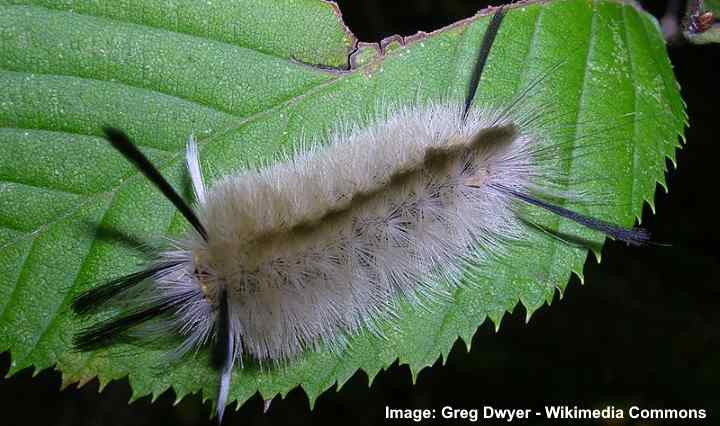
Banded Tussock Moth Caterpillar (Halysidota tessellaris)
The banded tussock moth larva is a fuzzy caterpillar covered in silvery-gray hairs. Like many tussock moth larvae, this species has tufts of long pencil hairs at its rear and head. A characteristic of this caterpillar is the blackish stripe along its back. It has a bright orange head and sometimes yellow spots along its body.
The banded tussock moth caterpillar grows up to 1.4” (3.5 cm) long. Its fuzzy appearance may look harmless, but the thin setae can cause skin irritation if you handle it.
- Adult Stage: Banded tussock moth or pale tiger moth
- Host Plants: Feeds on the foliage of various trees and shrubs, including oak, alder, hickory, maple, walnut, cherry, and apple
- Habitat and Distribution: Found in forests, woodlands, and gardens across Central and Eastern North America
- Stinging: The banded tussock moth caterpillar has urticating spines that can get lodged into the skin and cause irritation
Sycamore Moth Caterpillar (Acronicta aceris)
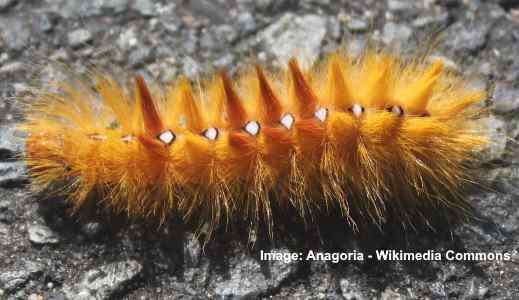
The fuzzy sycamore moth caterpillar has orange-yellow hairs and white dots along its body
The sycamore moth larva is a striking orange caterpillar with a distinct fuzzy appearance. Identifying features of the small caterpillar are its conical orange tufts, fuzzy setae, and a row of prominent white spots down the middle of its back. Sometimes, the caterpillar has a white line rather than individual dots.
The sycamore moth caterpillar grows up to 1.5” (4 cm) long. The brightly colored orange or yellow caterpillar is commonly seen on maple trees in late summer and early fall. Despite its beautiful appearance, its hairs are irritating and can irritate the skin when touched.
- Adult Stage: Sycamore moth
- Host Plants: Feeds on the foliage of sycamore, maple, oak, and other deciduous trees
- Habitat and Distribution: Found in deciduous forests, woodlands, and gardens across North America
- Stinging: The sycamore moth caterpillar has irritating setae
Milkweed Tiger Moth Caterpillar (Euchaetes egle)
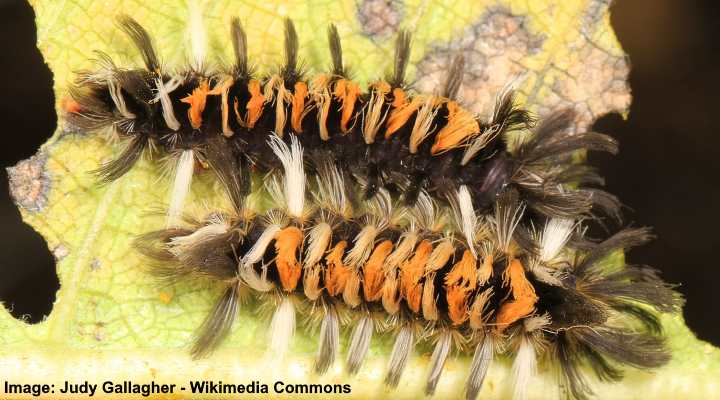
The small milkweed tiger moth caterpillar has white, black and orange hairy tufts
The milkweed tiger moth larva is a colorful caterpillar that stands out with its black and orange-striped body. It has clusters of black, orange, and white tufts covering its cylindrical body. The caterpillar has a black head. It is often found feeding in groups of up to ten larvae.
The milkweed tiger moth caterpillar grows up to 1.4” (3.5 cm) long. It feeds gregariously on milkweed plants, skeletonizing leaves as it goes through its growth stages.
- Adult Stage: Milkweed tiger moth or milkweed tussock moth
- Host Plants: Feeds mostly on milkweed plants and sometimes on dogbane leaves
- Habitat and Distribution: Found in meadows, fields, and gardens across North America
- Stinging: The milkweed tiger moth caterpillar does not have stinging spines; rather, its setae cause skin irritation
Yellow Woolly Bear Caterpillar (Spilosoma virginica)
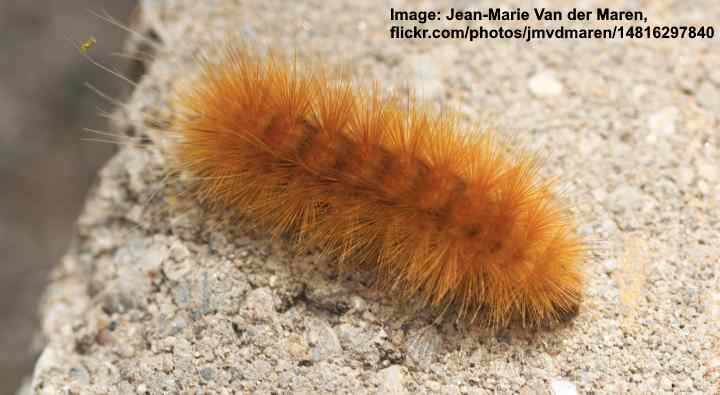
The yellow woolly bear is a common type of furry caterpillar
The yellow woolly bear caterpillar is a common fuzzy yellow or pale orange caterpillar. The slug-like larva has a cylindrical body covered in tufts of orange hairs. It also has longer hairs protruding from its sides and back. As it grows, it develops black bands in the middle of its body.
The yellow woolly bear caterpillar grows up to 2” (5 cm) long. The mature larvae form a cocoon in leaf litter on the soil’s surface before adult moths emerge the following spring.
- Adult Stage: Virginia tiger moth
- Host Plants: Feeds on the foliage of various low-growing plants, including dandelion, sunflower, goldenrod, grasses, and asters
- Habitat and Distribution: Found in meadows, fields, gardens, and other open areas across North America
- Stinging: The yellow woolly bear caterpillar has irritating hairs that may cause a skin reaction in some people
Garden Tiger Moth Caterpillar (Arctia caja)

Garden Tiger Moth Caterpillar (Arctia caja)
The garden tiger moth caterpillar is a type of “woolly bear” caterpillar with a black and rusty orange hairy body. The small, fuzzy caterpillar is characterized by its black bristles and tufts of dark, coppery brown hairs covering its body. Sometimes, the caterpillar also has red markings along its sides.
The garden tiger moth caterpillar grows up to 2.4” (6 cm) long. It feeds on plants in the daisy family, which develop toxic compounds, making the caterpillar poisonous to predators. Its urticating hairs contain irritating compounds that can cause skin irritation and rashes.
- Adult Stage: Garden tiger moth or great tiger moth
- Host Plants: Feeds on the foliage of various plants in the daisy family, especially foxglove
- Habitat and Distribution: Found in gardens, meadows, and grasslands across North America and Europe
- Stinging: The garden tiger moth caterpillar has irritating hairs that can cause skin irritation and a rash if touched
Walnut Caterpillar (Datana integerrima)
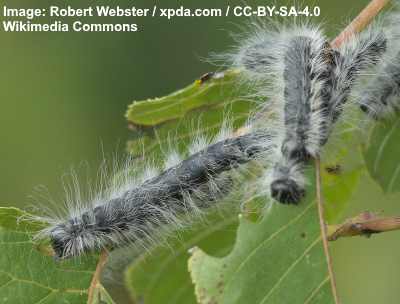
Walnut Caterpillars (Datana integerrima)
The walnut caterpillar is a black slug-like larva with a black body and rows of wispy spines. This harmless caterpillar has a rounded black head and rows of spindly gray hairs. A distinctive feature of the caterpillar is its habit of feeding in large groups on walnut trees.
The walnut caterpillar grows up to 1.1” (3 cm) long.
- Adult Stage: Walnut caterpillar moth
- Host Plants: Feeds on the foliage of walnut trees, as well as pecan and hickory
- Habitat and Distribution: Found in deciduous forests and woodlands in the eastern United States, particularly in areas with walnut trees
- Stinging: The walnut caterpillar is harmless because it lacks stinging spines and irritating setae
Salt Marsh Moth Caterpillar (Estigmene acrea)
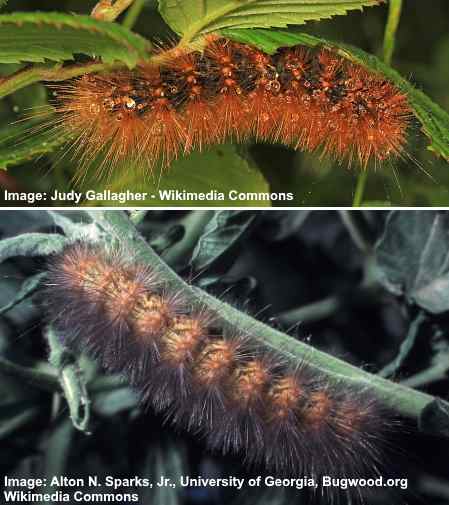
The hairy salt marsh caterpillar can vary in color from tan to dark brown, almost black
The salt marsh moth caterpillar is a fuzzy caterpillar that can appear pale yellow to rusty orange to dark brown-black colors. Identifying features of the larva are its segmented body with orange or black warts, a white dot on each segment, and tufts of soft setae.
The salt marsh moth caterpillar grows around 2” (5 cm) long. The larva creates a cocoon from its own hair before wrapping itself in a leaf to pupate. Yellow and orange adult moths emerge in spring.
- Adult Stage: Salt marsh moth or acrea moth
- Host Plants: Feeds on the foliage of various plants, including dandelion, clover, grasses, pea, potato, and low-growing shrubs
- Habitat and Distribution: Found in salt marshes, meadows, and gardens across North America
- Stinging: The salt marsh moth caterpillar does not have stinging spines and is generally harmless to humans
Fall Webworm (Hyphantria cunea)
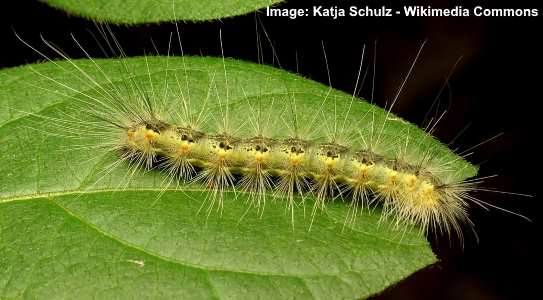
Fall Webworm (Hyphantria cunea)
The fall webworm is a long cigar-shaped caterpillar with variable coloration, ranging from dark gray to pale yellow. Common features of fall webworms are the two creamy stripes along the sides, tufts of long and short bristles, and yellow spots. The hungry caterpillars live in large tent-like structures at the ends of branches.
The fall webworm caterpillar grows up to 1.4” (3.5 cm) long. The defensive mechanisms of the caterpillar include irritating spiny hairs, repellent scents, and a jerking motion to deter predators.
- Adult Stage: Fall webworm moth
- Host Plants: Feeds on the foliage of most deciduous trees
- Habitat and Distribution: Found in forests, woodlands, and gardens across North America
- Stinging: The fall webworm caterpillar doesn’t sting, but its hairs can cause mild to severe skin irritation if touched
Pale Tussock Moth Caterpillar (Calliteara pudibunda)
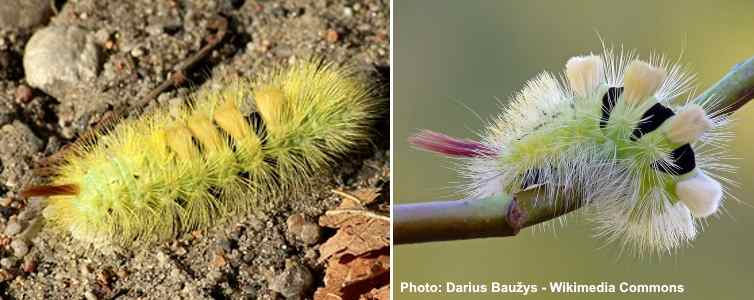
The pale tussock caterpillar has yellow tufts of hairs and black bands on its body
The pale tussock moth caterpillar is a striking hairy caterpillar with bright lemon-yellow hairs covering its body. Distinctive features of the caterpillar are its four toothbrush-like creamy white tufts, black bands, and a lime-green body. Additionally, the fuzzy larva has pronounced red pencil hairs at its tail end.
The pale tussock moth caterpillar grows up to 2” (5 cm) long. Despite its soft, fuzzy appearance, touching the hairs can cause skin irritation. Color variations mean the caterpillar sometimes has a rusty brown color.
- Adult Stage: Pale tussock moth
- Host Plants: Feeds on the foliage of various trees, including oak, birch, willow, and apple
- Habitat and Distribution: Found in forests, woodlands, and gardens across Europe and Asia
- Stinging: The pale tussock moth caterpillar has urticating hairs that can cause skin irritation; however, it doesn’t sting
Fox Moth Caterpillar (Macrothylacia rubi)
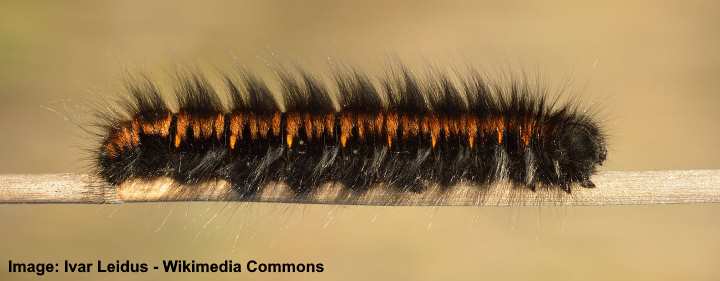
The furry black fox moth caterpillar has orange marking along its back
The fox moth caterpillar is a large, striking black and orange caterpillar with a hairy appearance. It has a black body covered in tufts of black hairs. Also, orange or yellow stripes along its back create a striking appearance. The caterpillar also has a rounded black face.
The fox moth caterpillar can grow up to 3.1” (8 cm) long. As the thick, fat larva matures, it loses its orange markings and develops a darker appearance. However, it is always covered in black or tawny colored setae.
- Adult Stage: Fox moth
- Host Plants: Feeds on the foliage of various plants, including heather, bilberry, and other low-growing shrubs
- Habitat and Distribution: Found in heathlands, damp meadows, and moorlands across Western Europe, including parts of the United Kingdom
- Stinging: The fox moth caterpillar has stinging spines that can cause skin irritation, nausea, and numbness
Virginia Ctenucha Caterpillar (Ctenucha virginica)
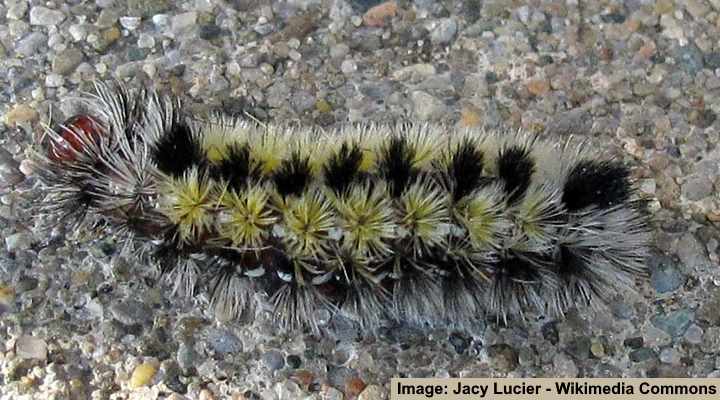
Virginia Ctenucha caterpillar (Ctenucha virginica)
The Virginia ctenucha is a beautiful hairy black and yellow caterpillar with pronounced tufts of hair covering its body. This striking caterpillar is easily recognized by its black, yellow, and white hairy tufts, its red head, and red prolegs. Some instars show the fuzzy caterpillar to be mostly white and yellow.
The small Virginia ctenucha caterpillar grows up to 1” (2.5 cm) long. Endemic to North America, the Virginia ctenucha develops into a stunning metallic-blue moth with a bright orange head.
- Adult Stage: Virginia ctenucha moth
- Host Plants: Feeds on the foliage of various plants, including grasses, irises, sedges, and other herbaceous plants
- Habitat and Distribution: Found in wetlands, meadows, and gardens across North America
- Stinging: The Virginia ctenucha caterpillar does not have stinging spines, but its urticating hairy tufts can cause skin irritation or allergic reactions
Peacock Caterpillar (Aglais io)
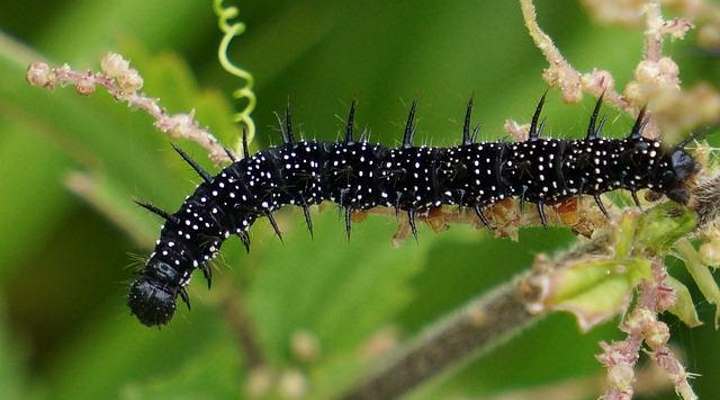
The Peacock caterpillar can be identified by its black bristles and tiny white dots on its body
The peacock caterpillar is a long black, white-spotted caterpillar with fleshy black spines. This butterfly caterpillar has a long, cylindrical black body covered in white speckles. Each segment contains pointed protrusions with small barb-like spines. It has a round head and thin white hairs sparsely covering its black body.
The peacock caterpillar grows up to 1.6” (4.2 cm) long. The caterpillar builds nests of silken threads covering the host plant. The black caterpillar emerges from the cocoon as a beautiful reddish butterfly with eye-like markings on its wings.
- Adult Stage: Peacock butterfly
- Host Plants: Feeds on stinging nettle, as well as other plants in the nettle family
- Habitat and Distribution: Found in woodlands, meadows, and gardens in Europe and part of Asia
- Stinging: The peacock caterpillar doesn’t sting despite its sharp-looking flesh spines
Red Admiral Caterpillar (Vanessa atalanta)
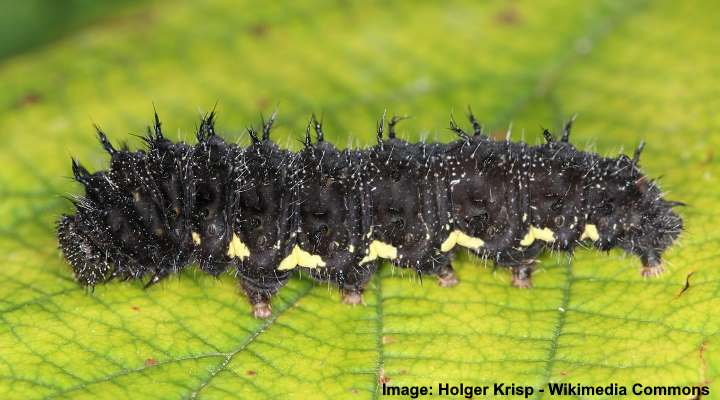
The red admiral caterpillar has black spiky body with tiny white dots
The red admiral caterpillar is a striking, stumpy caterpillar with a black body covered in rows of fleshy spines. Identifying features of the caterpillar are its yellow markings along its sides, small white hairs, and tiny white dots on its back, prolegs, and sides. Late instars show the caterpillar as a dark brown, white-spotted larva.
The red admiral caterpillar grows up to 1.4” (3.5 cm) long. The black, spiky caterpillar turns into an attractive butterfly with dark brown wings and vibrant red bands.
- Adult Stage: Red admiral butterfly
- Host Plants: Feeds on the foliage of nettles, false nettles, and other plants
- Habitat and Distribution: Found in gardens, meadows, woodlands, and other open areas across North America from March through October
- Stinging: The red admiral caterpillar does not have stinging spines
Sweet Gale Moth Caterpillar (Acronicta euphorbiae)
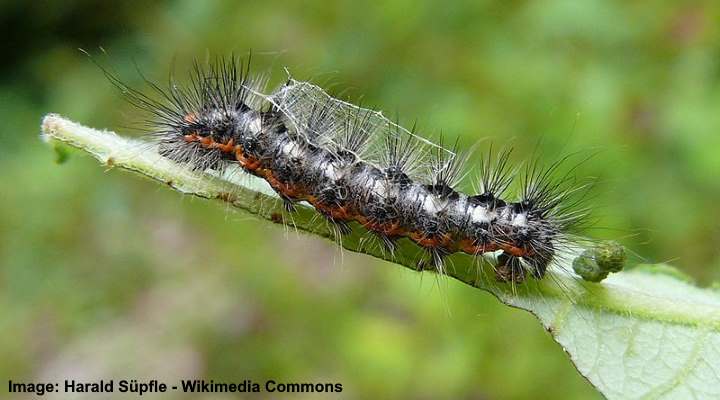
Sweet Gale Moth Caterpillar (Acronicta euphorbiae)
The sweet gale moth caterpillar is a small caterpillar with a black body covered in tufts of black and white hairs. This spiky black caterpillar has a noticeable orange-red band along its sides and a faint grayish-silver band on its back. Later instars show the caterpillar with gray, orange, and white stripes along its body.
The sweet gale moth caterpillar grows up to 1.3” (3.3 cm) long. After pupation, it emerges from the cocoon as a colorful, furry brown moth with white and gray mottled wing patterns.
- Adult Stage: Sweet gale moth
- Host Plants: Feeds on the foliage of heather, willow, yarrows, sorrels, and other shrubs
- Habitat and Distribution: Found on warm sunny slopes, moorlands, grassy heaths, and forests across Northern Europe
- Stinging: The sweet gale moth caterpillar has stinging spines that can cause skin irritation if touched
Erasmia pulchella
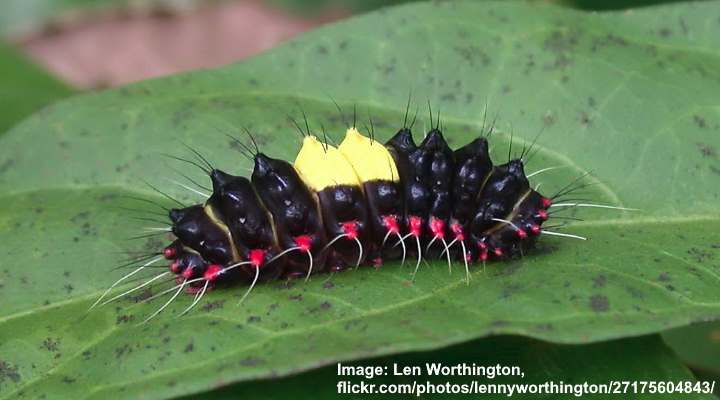
The Erasmia pulchella caterpillar has a shiny black body with yellow patch on the back, red dots on the sides and is covered with spikes
Erasmia pulchella is an eye-catching black caterpillar known for its vibrant two yellow central segments. The spiny larva is recognized by its bumpy segments and red spines along its sides, which have long white hairs. The black and yellow caterpillar also exudes toxic compounds as a defense mechanism.
The beautiful erasmia caterpillar grows up to 1.5 inches (3.8 cm) long. After going through its larval stage, the beautiful erasmia caterpillar spins a cocoon and transforms into an adult moth. The adult moth is known for its colorful and intricate patterns, making it a beautiful moth.
- Adult Stage: Erasmia pulchella moth
- Host Plants: Feeds on the foliage of Helicia shrubs common in Asia and tropical climates
- Habitat and Distribution: Native to southeast Asia, where it thrives in tropical landscapes
- Stinging: The Erasmia pulchella caterpillar doesn’t have stinging spines
Copper Underwing Moth Caterpillar (Amphipyra pyramidoides)
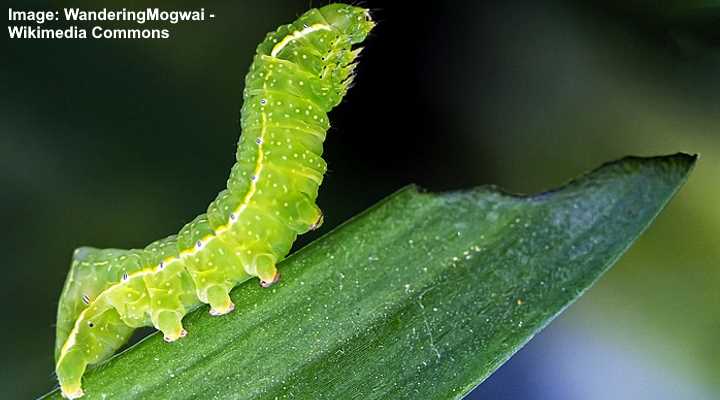
Copper Underwing Moth Caterpillar (Amphipyra pyramidoides)
The copper underwing moth caterpillar is a large lime green caterpillar with a yellow and white stripe running along its sides. Similar to hornworms, the large, plump larva has dotted pale green dots, tiny eye-like markings, and a pronounced bump at its tail end. When resting, the caterpillar lifts its front end.
The copper underwing moth caterpillar grows up to 2” (5 cm) long. Despite its size, it is often well hidden among the leaves of its host plants thanks to its green color. After pupation, the caterpillar is a stunning moth with coppery underwings.
- Adult Stage: Copper underwing moth
- Host Plants: Feeds on the foliage of various trees, including oak, birch, maple, and willow
- Habitat and Distribution: Found in forests, woodlands, and gardens across the United States and Southern Canada
- Stinging: The copper underwing moth caterpillar is harmless and does not sting or cause skin irritation.
Oleander Hawk Moth Caterpillar (Daphnis nerii)
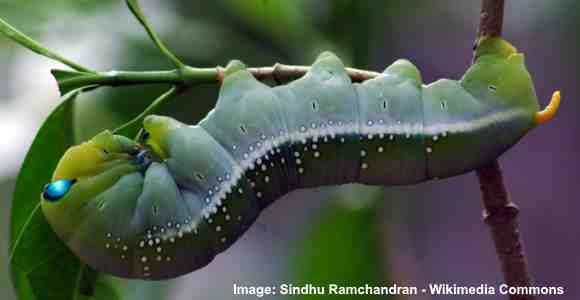
Oleander hawk moth caterpillar (Daphnis nerii)
The oleander hawk moth caterpillar is a large green caterpillar with fascinating metallic blue eyespots. The identifying features of this native caterpillar are its white stripe and spots along its sides, yellow tail-like protrusion, and short, stumpy prolegs on its center segments. Just before pupation, the caterpillar becomes brown.
The huge green oleander hawk moth caterpillar grows 3” to 3.3” (7.5 – 8.5 cm) long. After emerging from the cocoon, the insect is a stunning green moth with leaf-like patterns on its wings.
- Adult Stage: Oleander hawk moth
- Host Plants: Feeds on the foliage of oleander, jasmine, honeysuckle, and petunias
- Habitat and Distribution: Found in warm and tropical regions, including Asia, Africa, Hawaii, and parts of Southern Europe
- Stinging: The oleander hawk moth caterpillar does not have stinger or urticating spines
Box Tree Moth Caterpillar (Cydalima perspectalis)
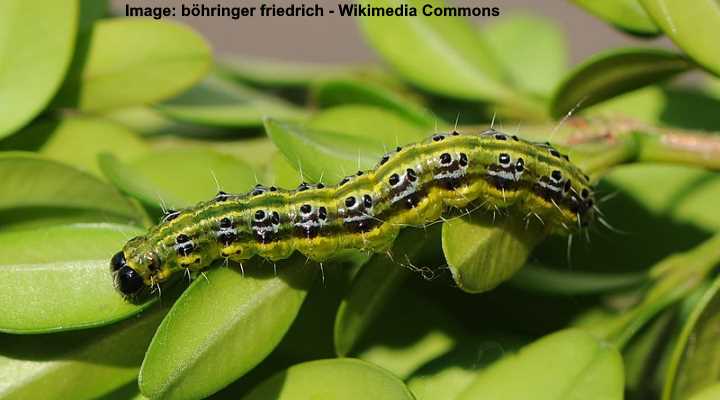
Box Tree Caterpillar (Cydalima perspectalis)
The box tree moth larva is a green caterpillar identified by its black, yellow, and white longitudinal stripes. The striped caterpillar also features black tubercles with white spines and pairs of black bumps in two rows. The stripy caterpillar has a voracious appetite and can quickly defoliate boxwood plants if left unchecked.
- Adult Stage: Box tree moth
- Host Plants: Feeds exclusively on leaves and shoots of boxwood plants
- Habitat and Distribution: Originally from East Asia, it has spread to gardens and landscapes across Europe, the eastern United States, and parts of Canada
- Stinging: The box tree moth larva is a harmless caterpillar
Promethea Silkmoth (Callosamia promethea)
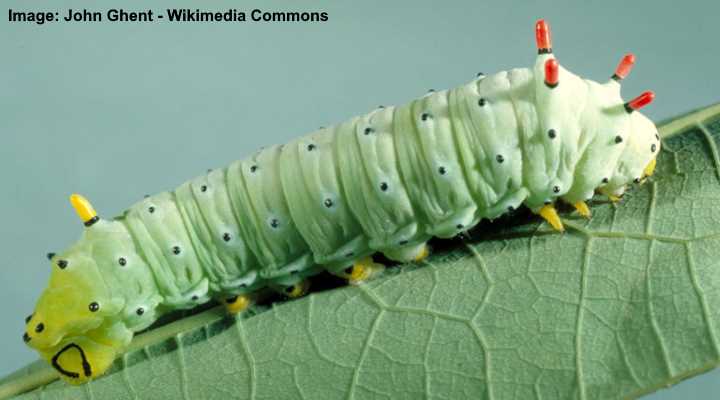
Promethea Silkmoth (Callosamia promethea)
The Promethea silkmoth is an unusual green caterpillar with colorful horns and prolegs. The caterpillar has a segmented lime-green body with four red protrusions at its head and a yellow one at its tail end. Also, rows of bluish dots run longitudinally on its plump green body.
The Promethea silkmoth caterpillar grows between 1.77” and 2.36” (4.5 – 6 cm) long. It’s easily recognizable due to its plump, cigar-like appearance. After pupating, it turns into a stunning large silk-producing moth with decorative brown wings.
- Adult Stage: Promethea silkmoth
- Host Plants: Feeds on leaves of rose, lilac, and laurel plants and also tulip trees and spicebushes
- Habitat and Distribution: The range of Promethea silkmoth is in deciduous forests extending from the east coast of the United States to the Great Plains.
- Stinging: The box tree moth larva is a harmless caterpillar without the ability to sting
Virginia Creeper Sphinx Moth Caterpillar (Darapsa Myron)
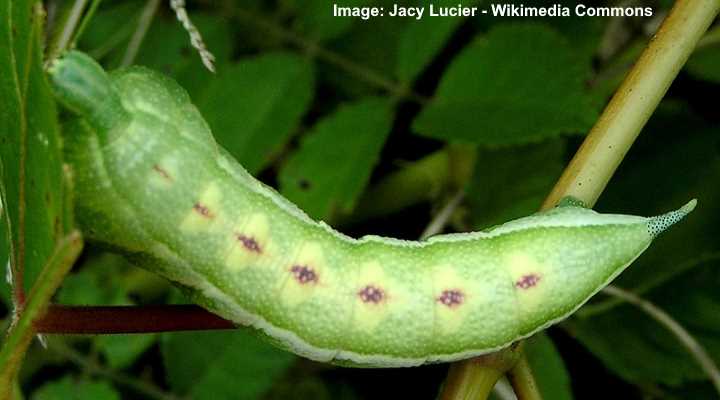
Virginia Creeper Sphinx Moth Caterpillar (Darapsa Myron)
The Virginia creeper sphinx moth larva is a large green caterpillar with diagonal white stripes on its sides. This unusual caterpillar also has a horn-like projection at its rear, small light green and brownish markings on its back, and a bulging head. It’s also covered in pale green speckles.
The robust Virginia creeper sphinx moth caterpillar grows 2” (5 cm) long. Before pupation, the caterpillar turns purplish-brown. It emerges from the cocoon as a beautiful brown moth.
- Adult Stage: Virginia creeper sphinx moth
- Host Plants: Feeds on the foliage of Virginia creeper, grape, tomato, and other plants
- Habitat and Distribution: Found in forests, woodlands, and gardens across the central and eastern United States
- Stinging: The Virginia creeper sphinx moth caterpillar does not have stinging spines or hairs
Gray Furcula Moth Caterpillar (Furcula cinerea)
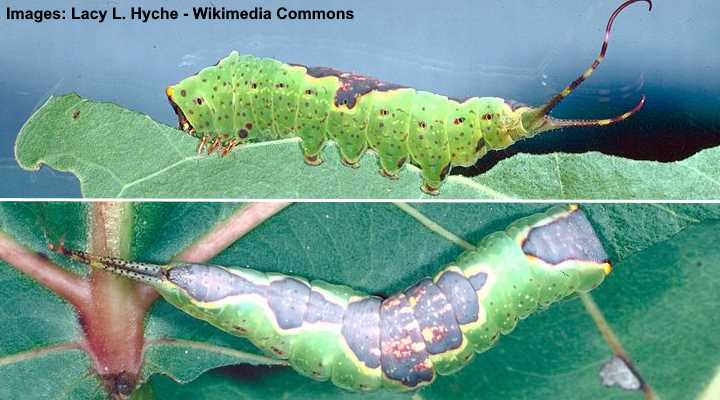
Gray Furcula Moth Caterpillar (Furcula cinerea)
The gray furcula moth larva is a unique caterpillar with a bright green and brown leaf-like pattern on its back. This strange caterpillar has a distinct humpbacked appearance, a pair of long, curved horns at its rear, and two smaller horn-like projections at its flattened head.
The gray furcula moth caterpillar can grow up to 2” (5 cm) long. It’s hard to spot because of its green color and camouflage, resembling a decomposed leaf.
- Adult Stage: Gray furcula moth
- Host Plants: Feeds on the foliage of various trees, including oak, willow, hickory, birch, and beech
- Habitat and Distribution: Found in forests, woodlands, and gardens across North America
- Stinging: The gray furcula moth doesn’t sting or cause allergic reactions
Snowberry Clearwing Moth Caterpillar (Hemaris diffinis)
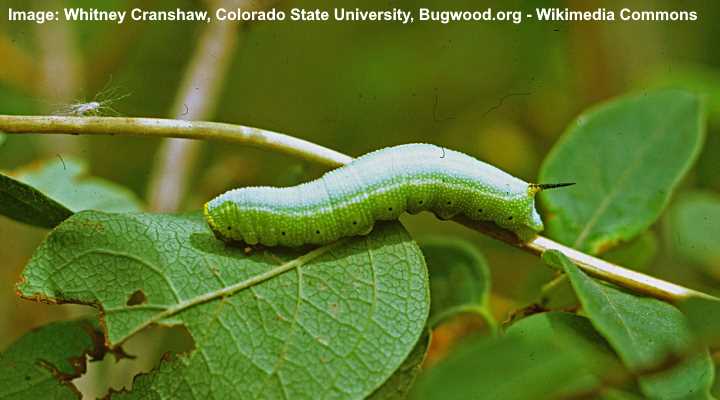
Snowberry Clearwing Moth Caterpillar (Hemaris diffinis)
The snowberry clearwing moth larva is a unique green caterpillar resembling a short, fat snake. The green caterpillar is identified by its bright green color, yellowish and bluish stripes, and a black horn-like projection on its rear end. The caterpillar also has small black dots and bumpy projections along its body.
The snowberry clearwing moth caterpillar grows up to 2” (5 cm) long. After pupation, the green caterpillar emerges as a small moth resembling a bumble bee or fuzzy hummingbird.
- Adult Stage: Snowberry clearwing moth or hummingbird moth
- Host Plants: Feeds on the leaves of various plants, including honeysuckle, snowberries, and dogbanes
- Habitat and Distribution: Found in open areas, meadows, gardens, and woodland edges across the United States
- Stinging: The snowberry clearwing moth caterpillar is harmless, and its horned projection cannot sting
Common Buckeye Caterpillar (Junonia coenia)
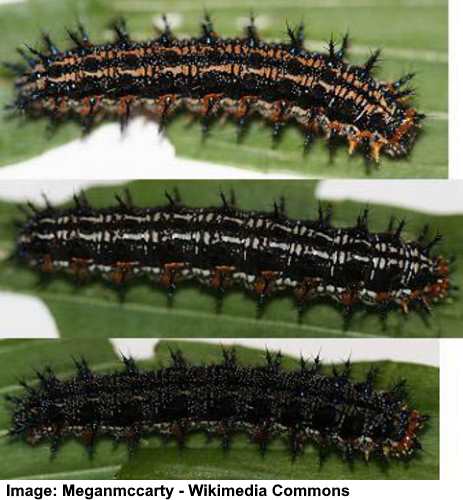
The black and brown common buckeye caterpillar has some color variations
The common buckeye caterpillar is a multi-colored, distinctive caterpillar with vibrant orange and black bands. Identifying features of the larva are its spiky projections along its body, bulbous orange head, and white and reddish-orange spots. Some color variations are black and white and almost entirely black.
The common buckeye caterpillar grows up to 1.6” (4 cm) long. The larva pupates by spinning a silky brown enclosure in the form of the letter “J.” The adult is a stunning brown and orange butterfly with several eyespots on its wings.
- Adult Stage: Common buckeye butterfly
- Host Plants: Feeds on the foliage of various plants, including plantain (Plantago), foxgloves, firecracker plants, and Mexican petunias
- Habitat and Distribution: Found in open areas, meadows, gardens, and parks across North America
- Stinging: The common buckeye caterpillar does not have stinging spines or hairs
Georgian Prominent Caterpillar (Hyperaeschra georgica)
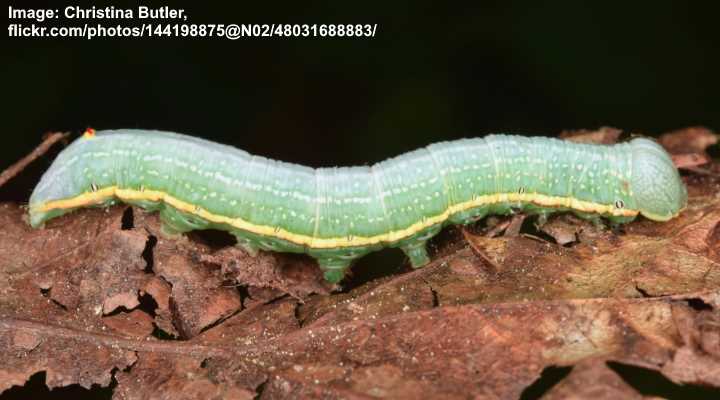
Georgian Prominent Caterpillar (Hyperaeschra georgica)
The Georgian prominent larva is a green caterpillar, easy to recognize due to its bright yellow stripe along its sides. Features of this large caterpillar are its pale green dotted rows, bulbous green head, and orange-red bump at its rear. It also has eyespots near its prolegs.
The Georgian prominent caterpillar can grow up to 1.6” (4 cm) long. The green caterpillar metamorphoses into a grayish-brown, fuzzy moth.
- Adult Stage: Georgian prominent moth
- Host Plants: Feeds on the foliage of various deciduous trees, including oak, hickory, maple, and cherry
- Habitat and Distribution: Found in forests, woodlands, and gardens across North America apart from the Pacific Northwest
- Stinging: The Georgian prominent caterpillar doesn’t sting
Imperial Moth Caterpillar (Eacles imperialis)
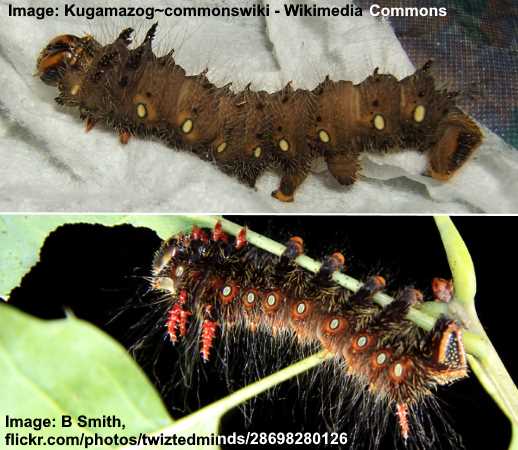
The large imperial moth caterpillar has dark brown body with spines and pale yellow spots along its sides
The imperial moth larva is a giant dark brown caterpillar with bumpy segments, yellow spots, and wispy setae. Other identifying features of the ugly caterpillar are its jagged-looking spines, bulbous orange and black head, and large barbed, black horn-like projections at its head. Through its growth stages, the caterpillar becomes dark until it looks almost black with bright yellow spots.
The imperial moth caterpillar grows up to 4” (10 cm) long. Despite its size and menacing appearance, the caterpillar isn’t aggressive and doesn’t sting. It burrows into the soil to pupate at maturity and eventually emerges as an adult moth.
- Adult Stage: Imperial moth
- Host Plants: Feeds on the foliage of various deciduous and coniferous trees, including pine, oak, hickory, walnut, and maple
- Habitat and Distribution: Found in forests, woodlands, and gardens across eastern North America
- Stinging: The imperial moth caterpillar does not have stinging spines; however, its irritating hairs may cause an itchy rash
Related articles:

